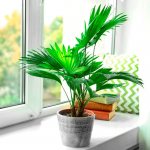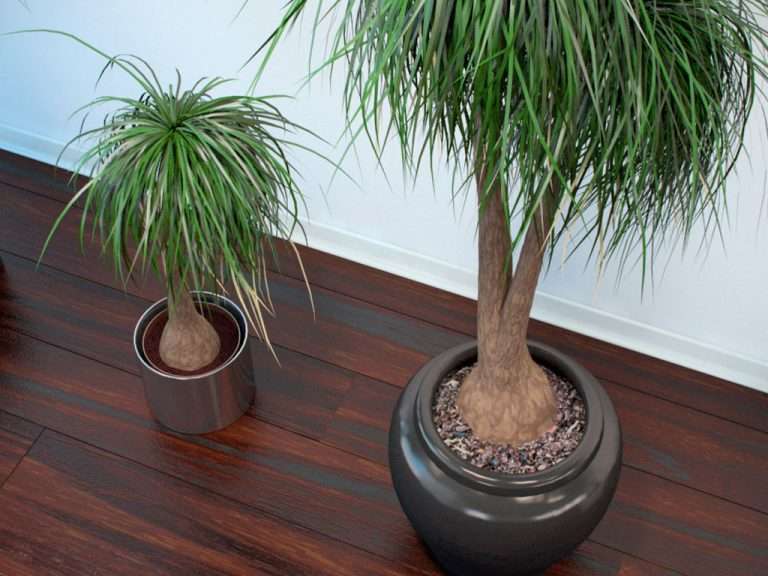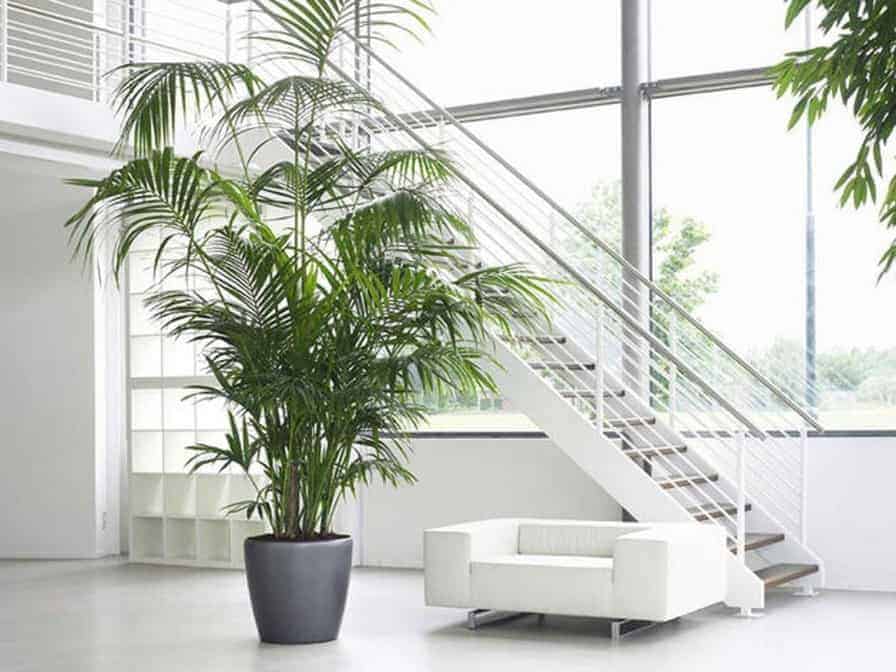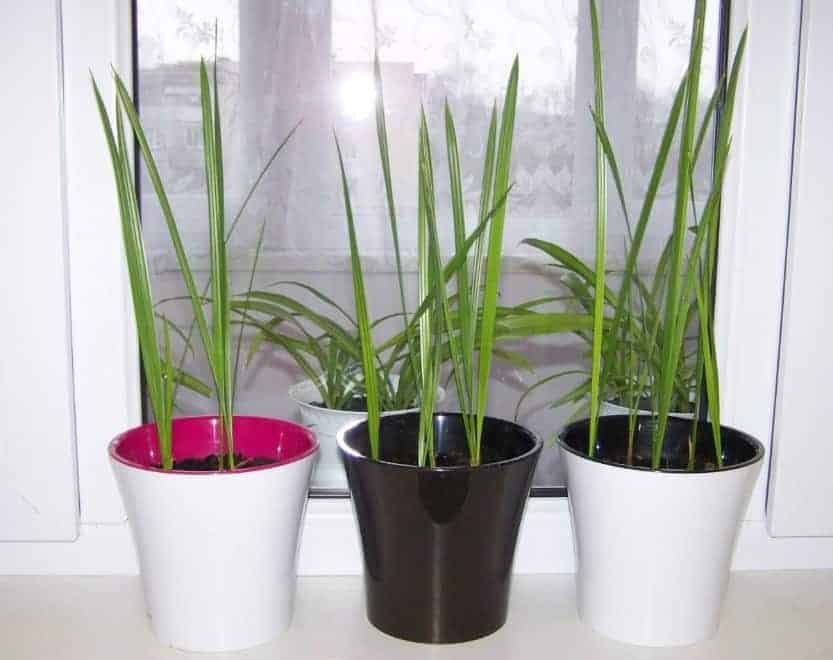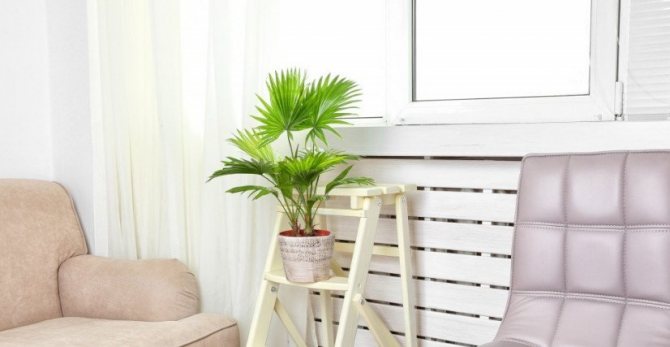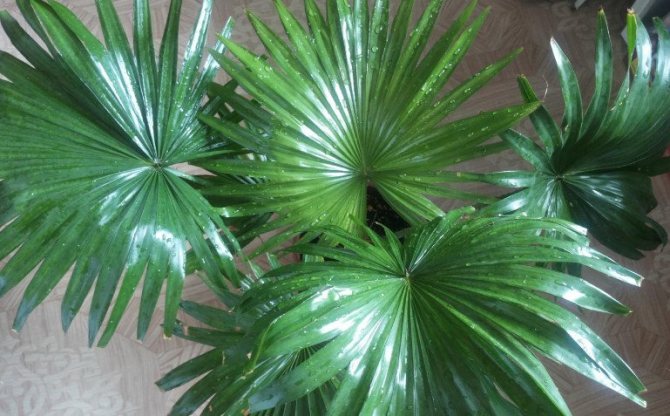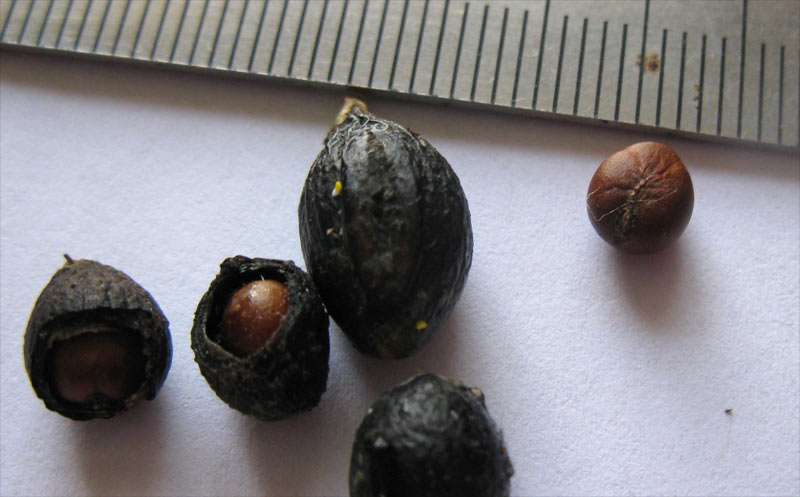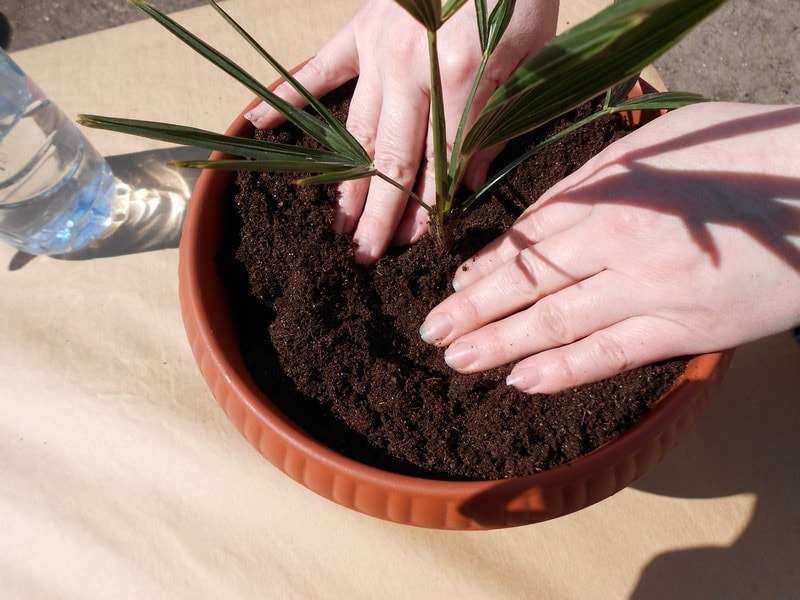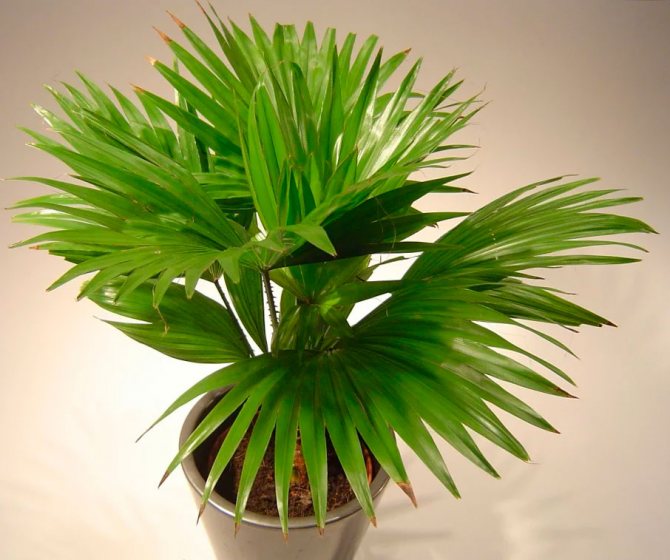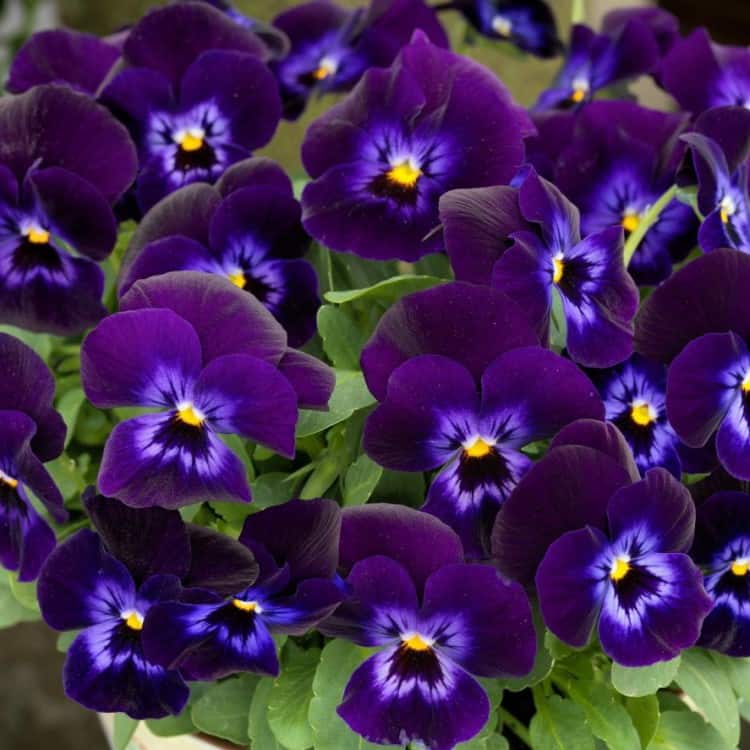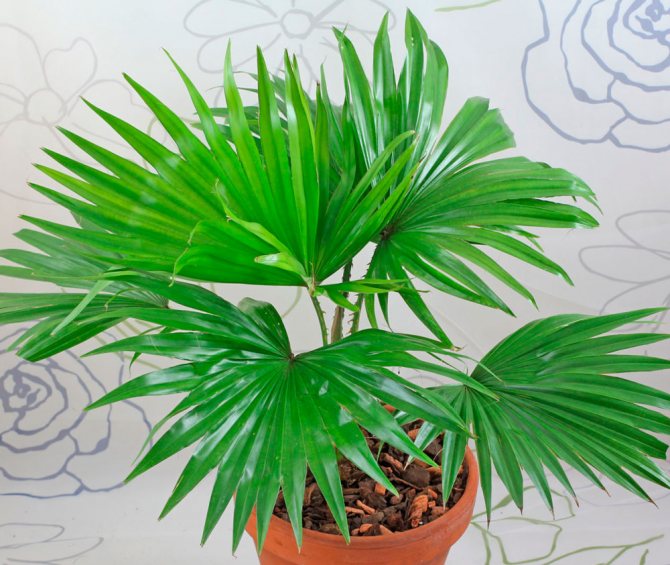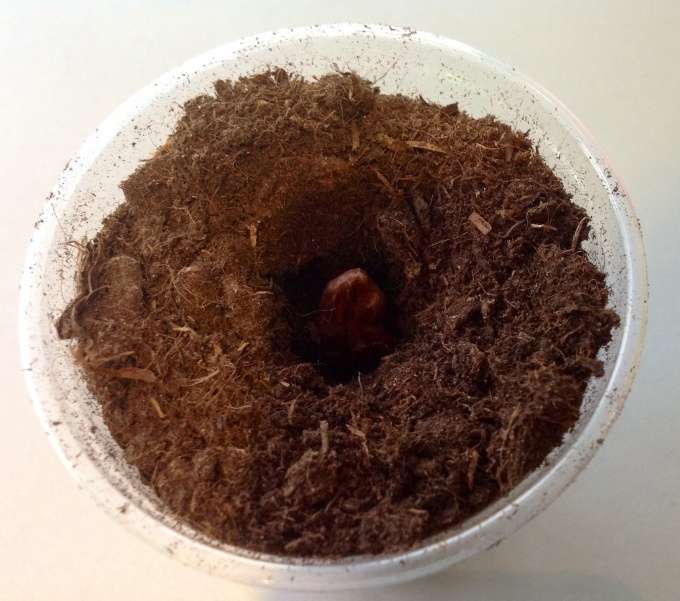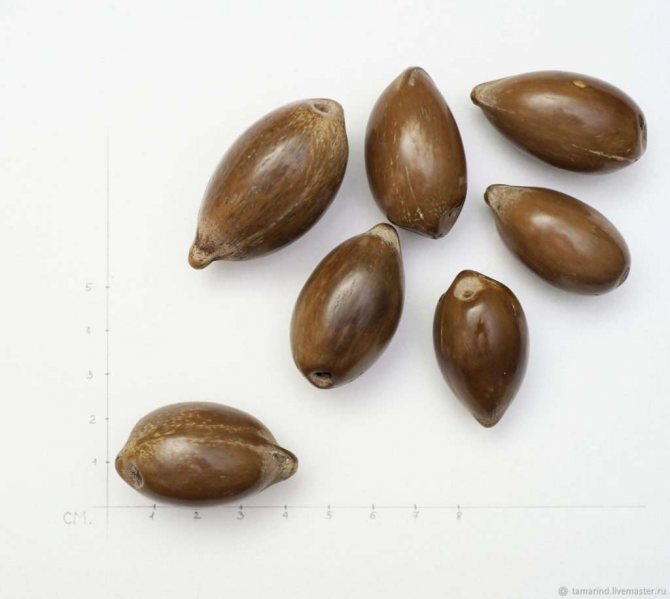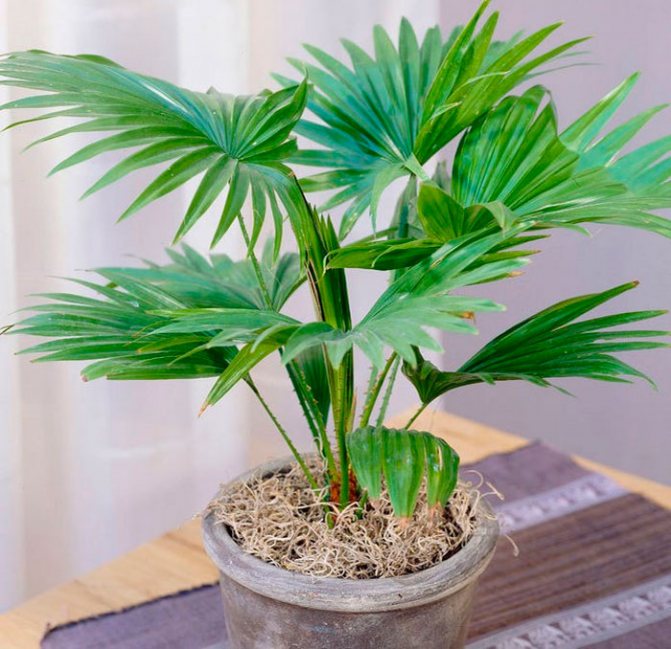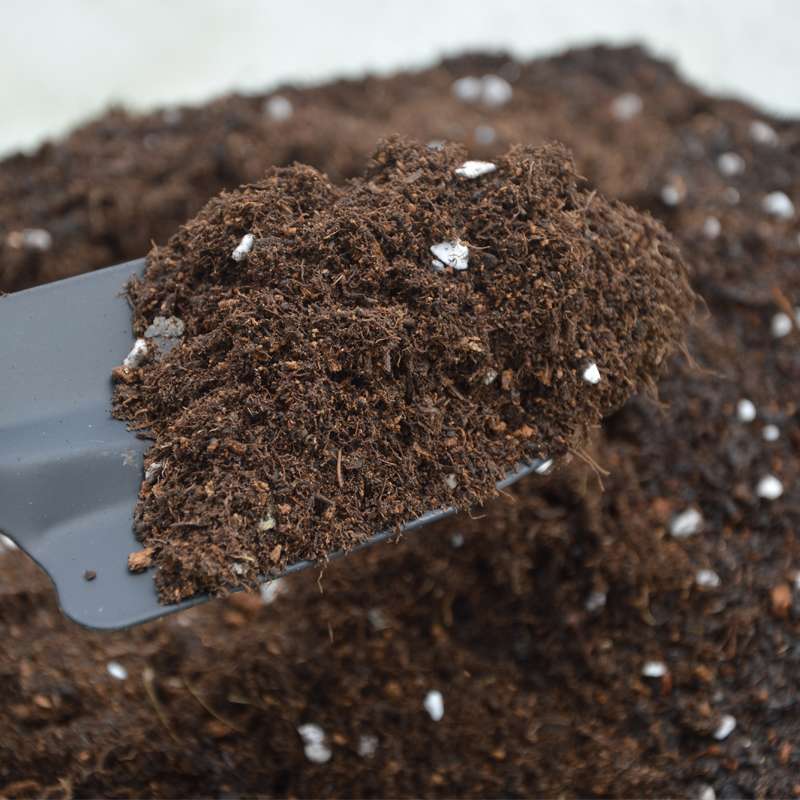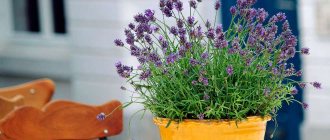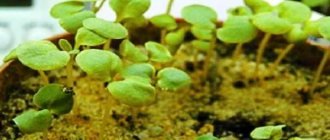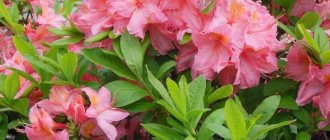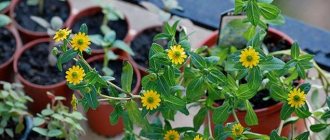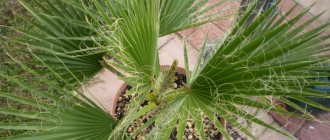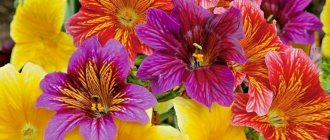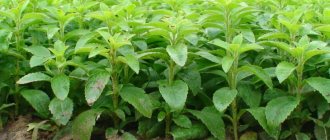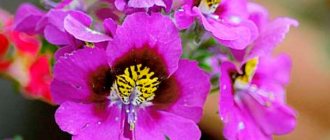The perennial plant Livistona is part of the Palm family. These plants are found naturally in Oceania, Southeast Asia, Australia and Africa. This genus was named in honor of the laird Livingston - Patrick Murray, who collected plants, and was also a student and friend of Andrew Balfour. This genus unites more than 30 species, and some of them are cultivated in greenhouses. However, there are also types of Liviston that can be grown at home.
Caring for Liviston at home. Briefly
| Temperature regime | In the warm season - 21-25 ° С, in the fall - gradually decrease, in winter - for subtropical species not lower than 5, not higher than 10 ° С and for tropical species - 17-20 ° С. |
| Air humidity | High. All varieties need systematic spraying in the summer season. |
| Lighting | Intensely diffused. Dark-leaved representatives grow well in shade. |
| Watering | In the spring-autumn period, they are moistened as the surface soil layer dries, in winter they are reduced to a minimum, so that a dry crust does not appear on top. |
| Priming | Loose, enriched and permeable to moisture. |
| Top dressing and fertilization | From spring to autumn, complex mineral compositions are added once every 7 days, in winter - once a month is enough. |
| Transfer | In early spring. Young specimens - every year, adults - every 3 years (according to the degree of filling the pot with a root ball). |
| Reproduction | Seed, cuttings and rhizome division. |
| Growing features | Cultivated as a decorative leafy representative. Falls into dormancy from late autumn to spring. Livistona does not bloom at home. In the summer they are taken out into the fresh air. Regular spraying and wiping of leaf plates is required. |
A brief description of the cultivation of Livistons
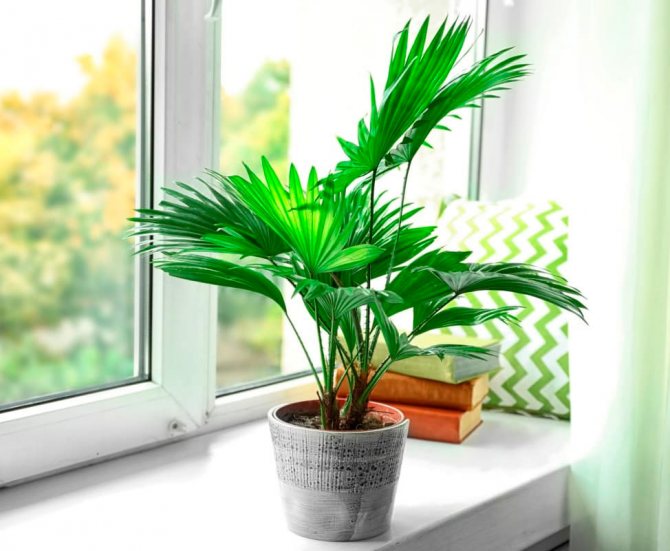
- Bloom... Liviston palm is grown as an ornamental deciduous plant.
- Illumination... A large amount of bright but diffused light is needed.
- Temperature regime... During the growing season - from 20 to 28 degrees, and in winter - from 14 to 18 degrees.
- Watering... During active growth, water is systematically and moderately, and during the dormant period - sparsely and rarely.
- Air humidity... High humidity is required. In summer and spring, it is recommended to systematically moisten the foliage from a sprayer with warm water every day.
- Fertilizer... Top dressing is carried out regularly once every 20-30 days from April to August, for this they use a complex mineral fertilizer for palms. It is also very useful to sometimes moisten foliage from a spray bottle with a solution of trace elements.
- Dormant period... Not pronounced. However, in winter, all processes associated with the growing season slow down.
- Transfer... If necessary, when the root system becomes cramped in the pot.
- Reproduction... Seeds.
- Diseases... Leaf spot, root rot, late blight, sclerotinia, wilting and chlorosis.
- Harmful insects... Thrips, mealybugs, scale insects, whiteflies and spider mites.
Caring for Liviston at home. In detail
Caring for Liviston at home is not particularly difficult. The palm is unassuming and grows well even with minimal care. Domestic Livistona, like wild-growing, prefers a lot of light and warmth, does not tolerate drafts.
Flowering livistons
Liviston palm does not bloom at home.
Therefore, it is grown mainly because of the decorative qualities of the foliage - feathery, large-scale, rich green color scheme.
Temperature regime
The palm tree, due to its tropical origin, is prone to high-temperature maintenance. In the summer, it is sufficient to maintain the environment within the range of 22-25 ° C, in winter it is lowered to 15-16 ° C.
A sharp short-term jump up to 10 ° C will not be destructive.
Spraying
Livistone needs high humidity, therefore, it should be sprayed regularly on hot days. Additionally, you can wipe the leaf plates with a damp cloth, as the plant actively collects dust.
In winter, it is necessary to spray, but much less often. An exception if the palm tree stands near heating appliances. To maintain a stable required air humidity, a humidifier is installed in the room.
Lighting
Livistona at home feels most comfortable on the south side, where there is enough sunlight. It is advisable to create light shading from the midday heat... The formation of the crown will be uniform if you systematically rotate the pot with the plant around its own axis so that the light flux equally falls on all sides. In summer, it is better to rearrange the palm tree in the garden or on the balcony, but where there is no wind blowing through.
Watering
Water regularly in summer, but without creating swampiness... Although the palm tree is moisture-loving, being in dampness leads to decay of the root system. The main thing is that the soil is constantly slightly moistened. In winter, the intensity of watering is reduced, but so that Livistona does not suffer from drought.
For irrigation, they take warm and previously settled water. After 2 hours, be sure to drain the water accumulated in the pan.
Pot for Livistona
The container for Livistons is selected spacious and deep, since the roots tend to grow strongly. It is also not recommended to take too large pots, otherwise the plant will use all its strength to develop the rhizome and slow down in growth. There must be drain holes at the bottom.
Soil for Livistona
The soil mixture can be bought ready-made (for palms) at a gardening store, or you can mix it yourself: garden turf soil, raw peat (humus) and river coarse sand. All components are taken in a 3: 1: 1 ratio.
Top dressing and fertilization
The most active growth in the palm tree is observed from April to November, which is associated with a high consumption of nutrient resources. At this time, fertilizing with balanced mineral and vitamin compositions will be required. Special fertilizers are suitable for palm representatives. They are brought in three times a month. Excess can cause plant disease.
Liviston transplant
After purchasing a palm tree, a transplant will be required, but not immediately. Wait 2-3 weeks until the plant adapts to new conditions.
Then it will not suffer so much from resettlement to another place of residence. Main landing activities:
- Prepare the substrate and pot.
- A drainage layer with a thickness of at least 3 cm is laid out on the bottom. Suitable for drainage: expanded clay, broken clay shards, small stones. Fertile soil is poured from above.
- To facilitate the extraction of the Livistons from the old pot, it is watered abundantly and left to soak for several hours.
- They grab the root ball along with the earth and transplant it to a new place.
- The free space is covered with a substrate, leaving the root collar ajar.
A domestic palm needs a transplant every 2-3 years, when the roots become cramped and they stick out. It is enough to relocate the old representatives once every five years, and the rest of the time to replace part of the surface layer of the earth. Excess root shoots are trimmed so that the palm tree fits comfortably in the new container.
Reproduction methods
Due to the fact that the palm tree grows with one trunk, there is no vegetative propagation method. Therefore, this plant is propagated by seeds. But it still happens that lateral processes are formed on the outwardly protruding roots. Then you can try to propagate the palm tree by offspring, although this is a rather rare and not the most successful method.
Find out what plants are recommended for offices, nurseries, bedrooms, balconies.
Sometimes it happens that after buying in one pot you can find several young trunks, then it makes sense to plant them in different containers. How to sit down:
- Dig in the ground and remove the trunks with roots.
- In no case should you cut the roots! Separate them very carefully with your fingers, being careful not to disturb the ground around them.
- Damaged roots must be lubricated with garden varnish.
- Place the plants in the holes, do not deepen.
- Sprinkle with earth and moisten.
The planting procedure must be carried out as quickly as possible, preventing the root system from drying out. Also, before seating, you need to consider the expediency of the procedure, because the Liviston palm reacts extremely painfully to contact and damage to the root system.
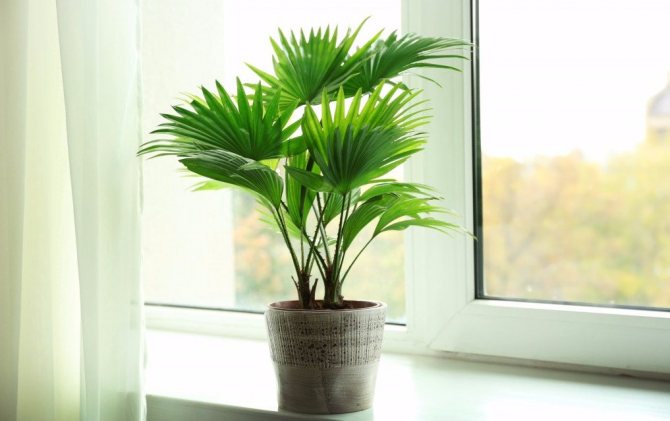

To grow a tropical beauty from seeds, you can follow the method described above. Seeds can be purchased online or at large garden shops. It is very important that when storing seeds, the temperature regime is not lower than + 15 ° C, otherwise the seeds will lose their viability, and your money and time will be wasted.
Although the producers indicate that the shelf life of seeds is several years, it is still better to purchase the material as fresh as possible. The longer the seeds have been stored, the longer the growing period will be.
The seeds should be intact, without damage, with an embryo inside, the color of which ranges from white to yellow. The color of the seed shell itself will differ for each subspecies of Livistona - from light beige to brown.
Did you know? In the 60s of the last century, during excavations of the palace of the Jewish king Herod, archaeologists discovered the seeds of a date palm, whose age exceeded 2 thousand years. After another 50 years, in 2005, scientists tried to grow trees from them. After careful preparatory procedures, one sprout emerged from three seeds, which was named Methuselah. Today the palm tree has grown to 2 meters!
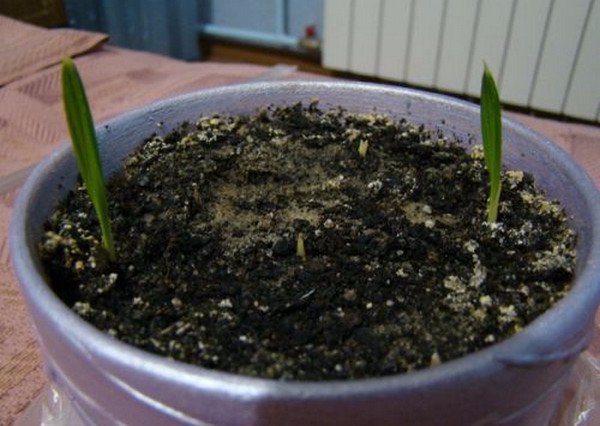

Growing Livistons from seeds
Of all the methods of reproduction of Livistons, seed is considered the simplest and most productive. The procedure is carried out in the time interval from February to March.
- Seed material is pre-soaked in water for 2 days.
- Plant one seed at a time in a pot to a depth of at least 1 cm.
- The soil must first be warmed up.
- Cover the seedlings with foil or glass to create a greenhouse effect. Placed in a sunny place and wait for the first shoots.
Care implies - regular moistening by surface spraying from a spray bottle or through a pallet and airing. With the appearance of strong shoots, the shelter is removed.
When do sprouts appear?
To say that I was able to grow a palm tree, a florist can not earlier than the appearance of a decorated adult plant. But even a fragile, yet weak sprout, hatching from the substrate, can be called the first victory. Palm-like, more often than not, are in no hurry to germinate and sometimes you have to wait a very long time.
Germination rate depends on several factors:
- plant species - some "hatch" after 3-4 weeks, others need six months for this;
It is interesting! Not waiting for germination in 6-7 months, it is too early to get upset. You may have come across some long-running specimens. For example, the seeds of a bootie, brachea or porcupine palm can germinate only after a year and a half!
- the duration of storage of seed material and conditions - seeds of tropical plants quickly lose their germination, which quickly sprout;
- seed preparation;
- scarification.
The freshest, competently prepared seeds sprout faster.
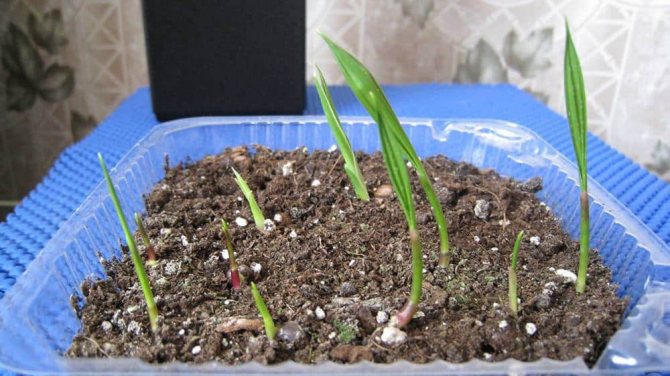

Diseases and pests
Liviston false palm is susceptible to a number of diseases, which are manifested by the following symptoms:
- Liviston leaves turn yellow - a consequence of insufficient watering;
- brown leaf tips livistons - excessively dry air in the living space;
- Liviston leaves wither - lack of moisture and too dry soil;
- Livistona leaves wither and darken - lowered temperature regime;
- Livistona is slowly growing - lack of fertilizers;
- the lower leaves darken and die off - This is a normal phenomenon inherent in old plants.
Of the parasites, the following are especially dangerous:
- shield;
- spider mite;
- mealybug;
- whitefly butterfly.
Growing features
It is impossible to grow a palm tree without knowing about the peculiarities of planting and care. Despite many reviews about the unpretentiousness of such plants, at home they grow slowly and require special attention from humans. It is also important that without the germination procedure, it will be impossible to get a beautiful and healthy tree. And other cultivation features are also important:
- preparation of soil mixture;
- sawing seeds;
- sowing and germination.
After going through all these preparatory activities, you can start planting. The main thing is to follow all the instructions in detail in order to get a tall tree as soon as possible.
For most species of these plants, ordinary flower soil will do. Such soil is the lightest and most nutritious for palms; problems with its quality rarely arise.
Read next: Maiden chrysanthemum Golden Bol Snow balls description of varieties
But if you plan to plant seeds of Hamedorea or Date Palm, you will have to make the soil mixture yourself, adding such components in equal proportions:
- perlite;
- vermiculite;
- deciduous land.
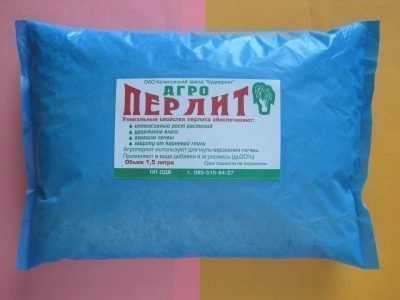

To prepare the soil mixture, you will need to take perlite
It is important to make drainage, with the help of which excess moisture will "go away" from the soil, thus avoiding rotting of the plant roots. In the first few weeks, the seeds most need air, which they take from the drainage gaps.
Sawing speeds up the germination process. The shell of the planting material is thick and without human assistance has less chance of germination. Therefore, you should carefully cut each seed with a knife, placing them in a solution of mineral fertilizers for 4 days.
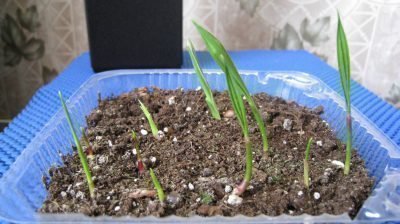

Top dressing will allow the planting material to get all the missing nutrients for germination. Before sowing, they must be washed with a weak solution of potassium permanganate.
Sowing and germination
Planting seeds will not cause difficulties even for an inexperienced gardener. Having prepared the planting material and pots with soil, you should:
- Moisten the soil.
- Sow several seeds in each pot at a distance of 3-4 cm from each other.
- Remove to a warm place.
Do not cover the pots with foil. Germination of a palm tree is a lengthy process. It can take 90 to 180 days to get the first shoots. During this time, it is important to fulfill all the features of plant care.
Types of homemade livistons with photos and names
Livistona chinensis, patching (Livistona chinensis)
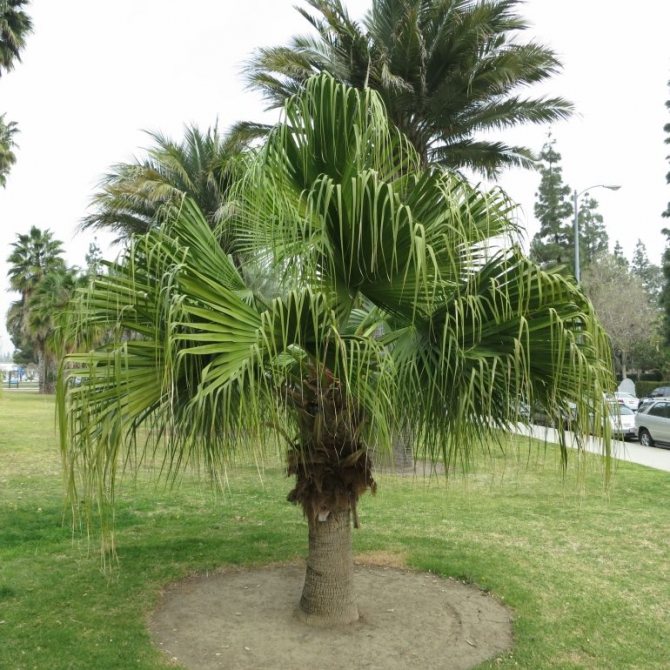

A native of the palm tree from southern China. She has a thick trunk with a circumference of up to half a meter, more than 10 m in height. At the base, it is bumpy, on top of the surface is fibrous with healed residual foliage. The leaf plates are large drooping fan-shaped, cut to half of the total length into bulky lobes 60-70 cm in size, which are pointed at the tips.
The leaves are attached to long, meter-long petioles 8-10 cm thick, which are covered with small thorns up to the middle, pressed into the leaf tissue. Inflorescences are of axillary type. The plant prefers a moderately humid and warm climate. It grows quite intensively, therefore, already at the age of three, it stands out for its high decorative indicators. The development of young leaves occurs subject to the preservation of the integrity of the tops.
Livistona southern (Livistona australis, Corypha australis)
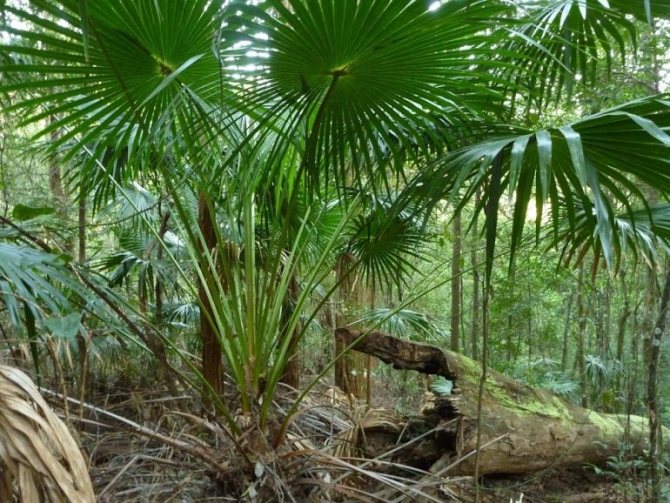

The wild palm grows in the subtropical humid woodlands of Eastern Australia, spreading all the way to the southern tip of Melbourne. The trunk is columnar more than 20 m in height, with a diameter of 35 and more centimeters. In the lower part it is considerably widened and covered with annular growths. The crown consists of fan-shaped large segmented two-meter leaves of a rich emerald color.
The petioles are narrow and strong, almost two meters long, completely covered with brown spines. Axillary inflorescences are branched. The best growth of this species of Livistona is observed in partial shade. Ideal for home cultivation.
Livistona rotundifolia
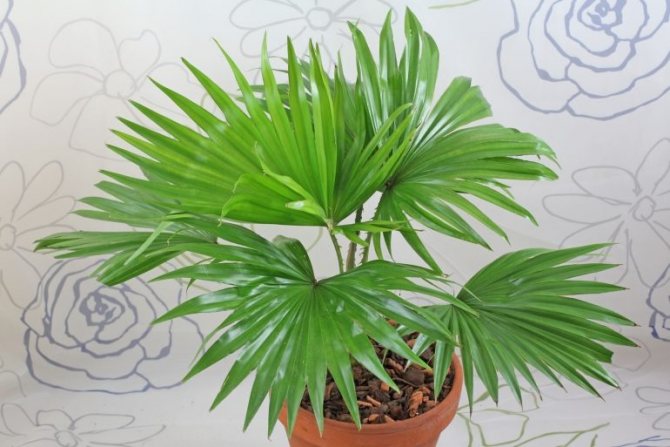

The distribution area of this variety of palm trees is the sandy regions of the island of Java and the Molluk Islands. The height of the plant is about 15 m, the diameter of the trunk is 15-18 cm. The leaf plates are dissected, rounded, about 1.5 m in diameter. The surface is shiny dark green.
The foliage is attached to elongated petioles, covered by a third of the length with multiple thorns, and move away from them in different directions, forming a circle. It is recommended to grow such a palm in rooms with moderate climatic conditions.
The genus Liviston has 30 plant species of the palm family. Patrick Murray, Lord of Liviston (1632-1671), who collected more than a thousand different plants in the garden, was awarded the name of this palm in honor of his name. South, Southeast Asia, the islands of the Malay Archipelago, the island of New Guinea, Polynesia, Eastern Australia are the places of distribution of the Livistonian palm.
These large palms, which love tropical and subtropical climates, reach a height of 20-25 cm. The trunk, covered with scars, depressions of the foliage petioles, has a crown at the top with fan-shaped, rounded leaves dissected towards the middle or deeper, the lobes of which are radially folded. The petioles are strong, the transverse cuts are convex, the edges are sharp with spines at the ends, the uvula is cordate. The petiole, elongated in the leaf plate, has the form of a rod, reaching a length of 5-20 cm, the inflorescences are axillary. The palm tree is able to clean the air well.
- Livistons are widely distributed as indoor plants.
- They are easy to propagate by seeds, grow quickly - already three-year-olds have a luxurious decorative appearance.
- Proper care gives about three new leaves a year, but the tops of the leaves can easily dry out, spreading this phenomenon much deeper, reducing decorativeness. Keeping the plant at a temperature of 16-18 ° C, frequent washing of leaves, spraying will prevent the described situation.
Watering the plants and a comfortable temperature
Watering should be abundant, but not excessive, the roots of the plant love water, but from the excess they begin to rot. Pay special attention to watering in the first 2 years of intensive growth, especially if the tub with the plant is located near a battery, air conditioner or heater.
The air humidity in the room with the plant should also be high. If you are not able to create such conditions, the leaves of the plant must be thoroughly sprayed with water. For spraying, use a simple spray bottle and filtered water; without such care, the leaves dry out.
Liviston palm care at home
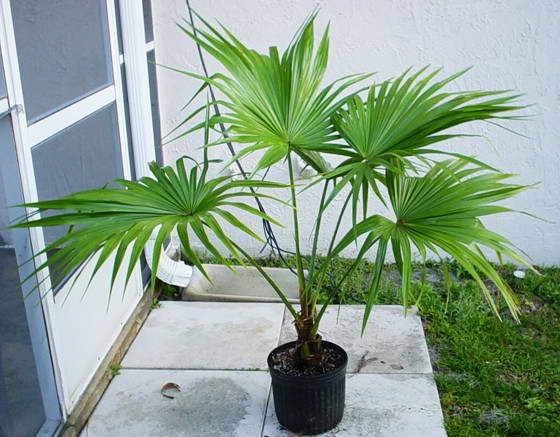

Livistona Chinese home care photo
Temperature regime
In summer, a moderate temperature of 21-24 ° C is required, in winter 14-16 ° C will be optimal, a short-term decrease to 10 ° C is permissible.
Lighting
The brightest spot is near the south window, direct sunlight is ideal. It is useful to periodically turn to the light in different directions so that development proceeds evenly. In summer, it is good to take the palm tree out into the garden, protecting it from strong winds.
Watering
- Water evenly, a little more often in summer, but without waterlogging, moderately in winter.
- It is important to keep the soil slightly damp.
- Overdrying an earthen coma leads to drooping leaves, the appearance of spots on them. Overflow - to decay of the roots and blackening of the leaves.
- Water only with warm water (a little warmer than room temperature, so that when your hands are lowered into the water, there is a feeling of warmth), be sure to stand, near the plant's trunk.
- After 2 hours, it is recommended to drain the water from the pallet (but try to water so that there is no excess moisture!).
How to feed Liviston
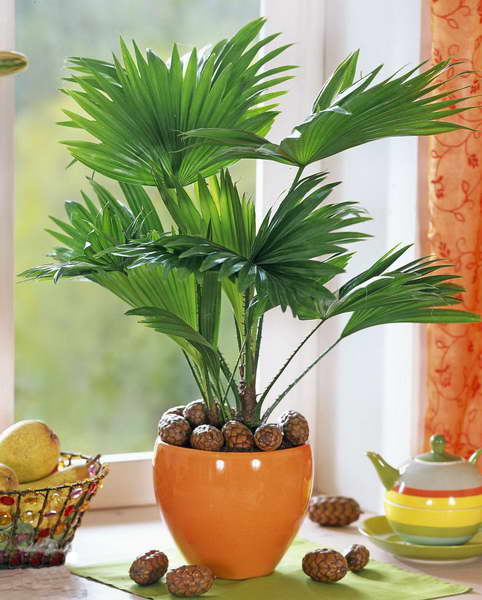

Livistona rotundifolia home care photo
Top dressing is carried out in April-November: the palm tree has a rapid consumption of nutrients during the stage of active growth. A slowdown in growth rates, yellowing of the leaves indicates a lack of nutrients.
- Use complex preparations for palm trees, adding top dressing 2-3 times a month.
- Do not be zealous with excessive feeding, otherwise the palm tree will get sick.
Air humidity
Spray Livistona regularly over the leaves from a fine spray, preferably twice a day, sometimes take a warm shower. A plant native to tropical countries, it needs constant air humidity. The lack of moisture is especially felt in winter, when the heating is on. To help the plant, install a humidifier or a container of sphagnum moss nearby.
Pruning
With the progressive drying of the leaf, cut off the tops of the leaf plates, do not rush to remove individual drying leaves, this will provoke the process of drying the next leaf. You can only remove a completely dried sheet.
How to care for sprouts?
Seedlings of palm trees can be confusing for novice florists. In some species, they are similar to each other and look like blades of grass - green with pointed tips. But in sago palms, the sprouts have a spherical shape, tightly rolled and pubescent balls grow, gradually unfolding and turning into a feathery leaf.
But more often, palm fry are bunches of blades of grass that do not remotely resemble an adult plant. And in order for the growth to turn into an exotic beauty, it is important to properly care for it: to provide suitable conditions and to know what fertilizers and feeding it needs. In fact, the sprouts need everything the adult palms do.
The soil
The easiest way is to use special soil for palm trees, which can be purchased at any store. They have all the necessary properties: lightness, looseness, moisture permeability. But you can also prepare a soil mixture on your own, which includes humus, turf and coarse sand in equal proportions. For a grown plant, it is better to change the composition of the soil - humus is replaced with peat.
Drainage must be placed on the bottom of the pot: fine gravel, brick chips, vermiculite or expanded clay. There must be holes in the container through which excess moisture comes out.
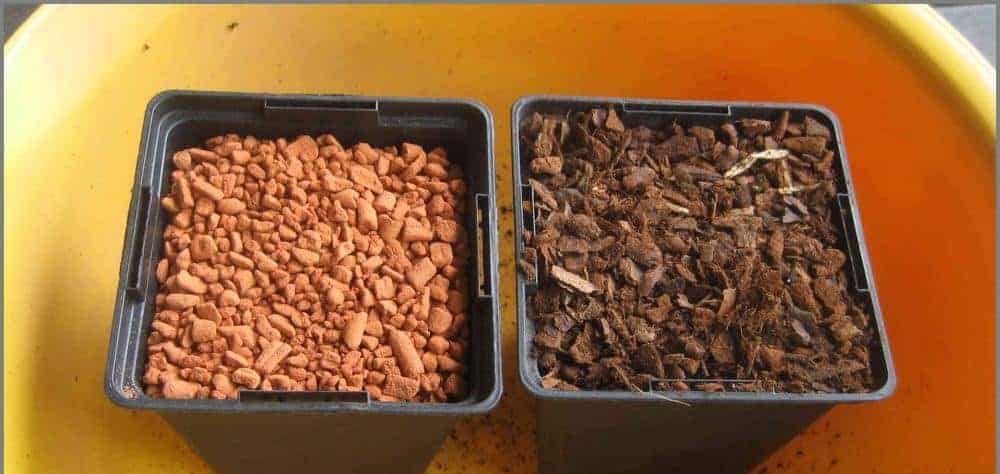

Lighting
All palms are light-requiring, in winter it is recommended to turn the plant pot so that the sun reaches all parts. But, on a hot afternoon, it is better to protect the flower from direct sunlight, the light should be diffused.
Humidity
When growing a palm tree at home, this aspect should be given special attention: the lower part of the soil mixture should be moist all the time, but dampness should not be allowed.
The leaves are periodically sprayed with a spray bottle to prevent yellowing from the dry air.And you can also put a container of water near the pot with sprouts.
Watering features
Regardless of the type of plant, water for irrigation should be at room temperature, it is pre-defended for several days. In winter, the number of irrigations decreases - once every 14-21 days is enough. In summer and spring, the plant is watered as needed when the soil dries out.
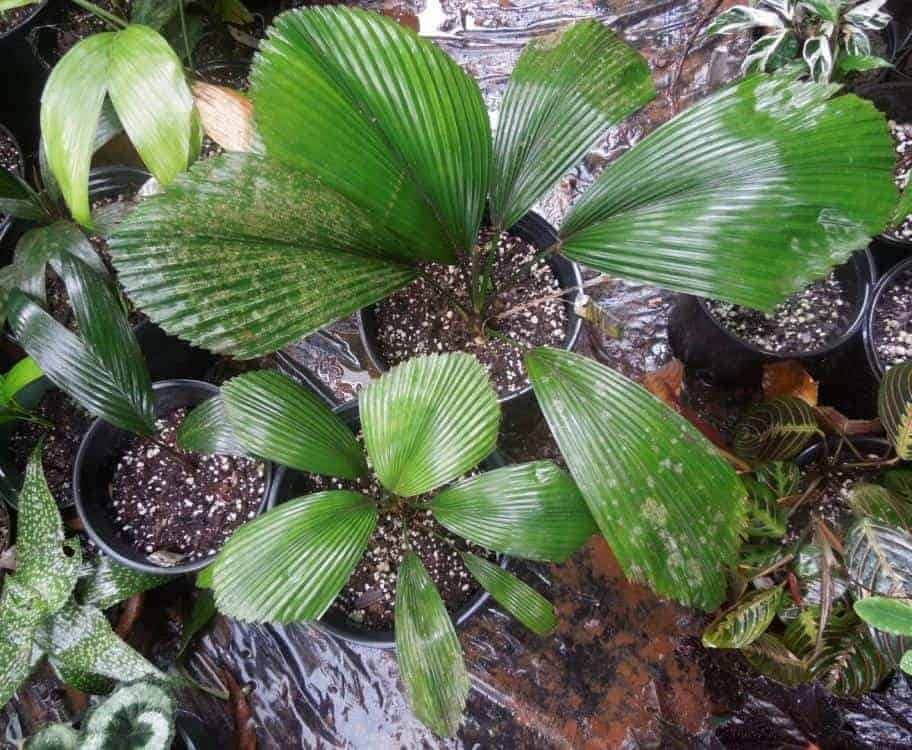

Livistona after purchase
The transport soil in which the plants for sale grow are not suitable for permanent maintenance. Quarantine the plant for two to three weeks. During this time, the palm tree will get used to your conditions and will not suffer much from transplanting.
- Prepare a special potting soil mixture by purchasing it from the store.
- Take a spacious, stable pot, put 2-3 cm of drainage from small stones on the bottom. Sprinkle a layer of earth on top.
- Pour over the liviston and let stand for 2-3 hours to soak the earthen ball.
- Remove the pot from the earthen ball without destroying it.
- Plant the Livistona in a new pot, sprinkle with earth around it.
- Do not deepen the root collar.
Conditions for seed germination
Seed germination requires moisture and warmth. There are certain requirements:
- Tropical varieties germinate at temperatures over 32 degrees Celsius.
- The subtropical requires a temperature of about 28 degrees Celsius.
- Desert palm species germinate at temperatures over 35 degrees Celsius.
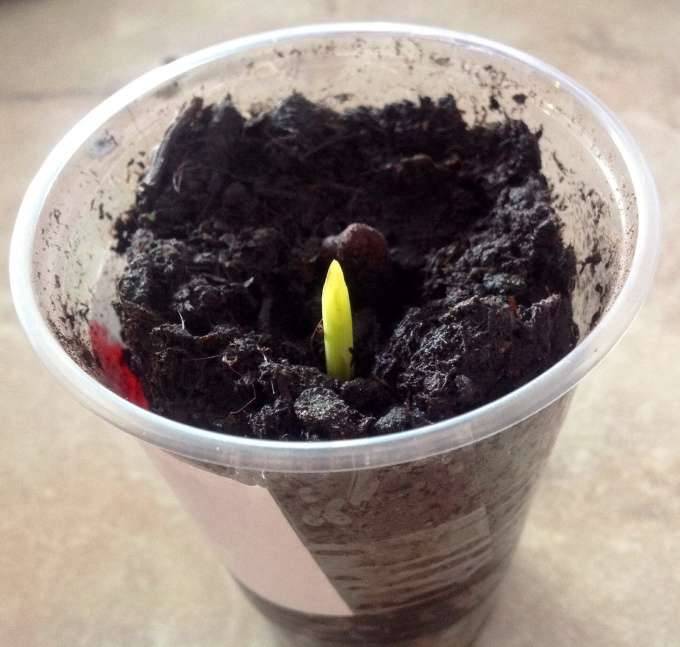

Some palms sprout in the light. That is why their seeds are not covered with soil. You can find out the features of sowing in the store where the material was bought.
Advice! The Jubaeopsis cafra palm is germinated only after seed stratification, Acrocomia and Lemurophoenix require high temperatures, Borassus flabellifer is germinated in very deep containers.
Liviston palm transplant
When filling the entire pot or tub with roots, when the roots crawl out, you need to urgently transplant the palm tree.
- Young palms are transplanted every year, mature plants - once every 2-3 years, adults need a transplant every 5 years.
- Part of the roots that formed the felt layer, cut off with a sharp knife so that the palm tree fits in a new container.
- Prepare a soil mixture: 2 portions of sod land + 2 portions of humus + one portion of peat, rotted manure, sand and add a little charcoal.
Palm transplant on video:
A drainage layer must be laid on the bottom of the palm pot. It can be small stone, pebbles, expanded clay and even crushed foam.
Seed size
When choosing a seed, beginners should be guided not by what the seeds of a palm tree look like, but by how to choose a healthy specimen. Only seeds that have a fertilized embryo can germinate. It is found at the time of stratification - mechanical damage to the peel.
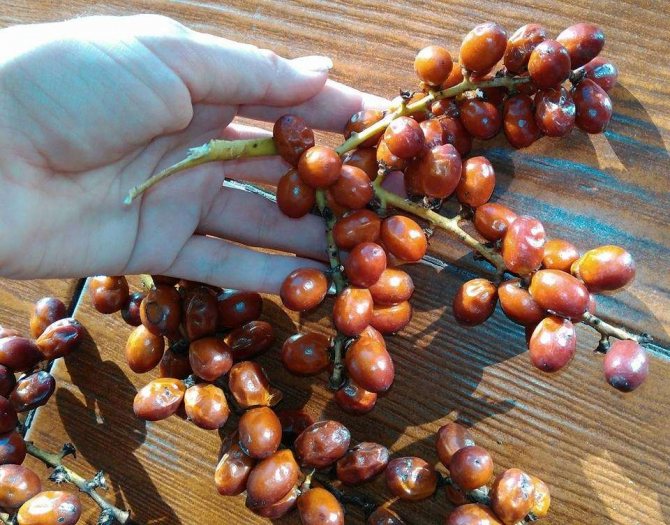

When determining the size of seeds, it is worth noting that each species has its own characteristics. The smallest seeds are only 5 mm long (Washingtonia), the largest weighing more than 20 kg.
Advice! When buying seeds, you should purchase at least 10-20 seeds in order to ensure that you get seedlings.
Livistona from seeds at home
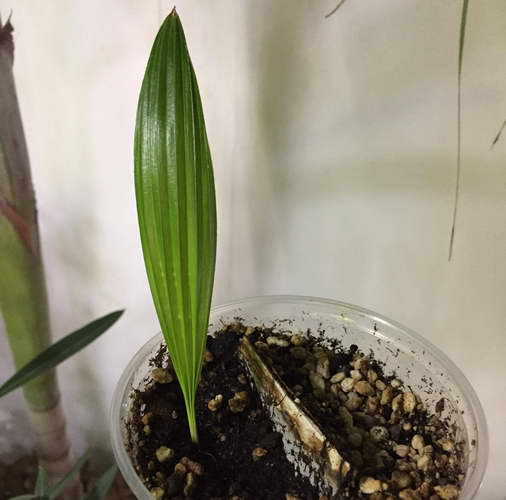

Liviston how to grow seedlings from seeds
Growing Livistons from seeds is an exciting and exciting process without being overwhelmed.
- Liviston can be planted with seeds throughout February and March.
- The seeds are pre-soaked in water for two days and planted one at a time in a pot.
- Embedding depth 1 cm, the soil must be warm.
- Crops are covered with glass or a bag, placed on a sunny warm window and sprouting is expected for up to three months.
- Maintenance consists in regular airing and watering through the pallet.
- When the plants rise a little and get stronger, the shelter is removed.
Growing
The Liviston palm is distinguished by its unpretentiousness, good adaptive abilities, ease of care and relatively fast growth.A tropical guest can be grown from seed or purchased from a store, below we will take a closer look at both methods.
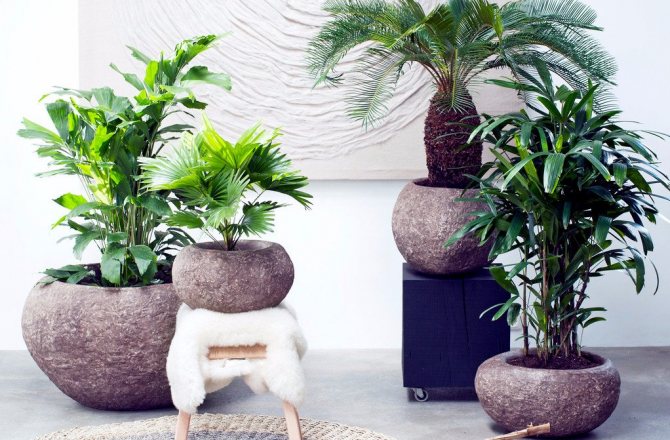

Learn more about how to grow chamedorea, date palm, yucca, Foster's Hovea, Belmora, cicas, chrysalidocarpus, pandanus, dracaena, pachypodium, cordilina at home.
Planting in palm soil
The soil (peat substrate) in which the plants are kept for sale is not suitable for permanent use, therefore the newly acquired plant will need to be transplanted. Immediately after the purchase, you should not do this - quarantine for 2-3 weeks so that the palm tree acclimatizes, gets used to the microclimate and experiences less stress during transplantation.
For planting in a permanent pot, prepare:
- soil for palm trees (sold in flower shops);
- a pot (you cannot take too large a container for a miniature plant, take a container in size, with good drainage holes);
- expanded clay, small stones or other drainage layer;
- potassium permanganate.
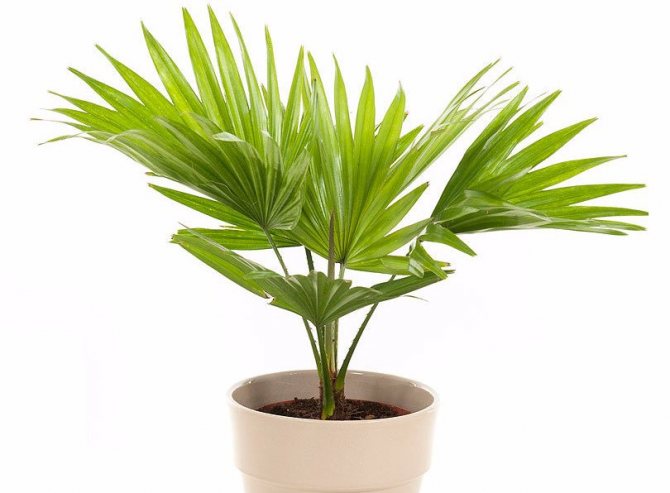

Algorithm of actions:
- Water the plant first to soften the soil.
- Next, carefully remove it from the pot, place it in a container with water with the addition of potassium permanganate, so that the peat lumps finally soften and disinfect.
- Clean the roots of any debris.
- Prepare the soil: You can use commercial ready-made palm soil or prepare it yourself from equal parts of sand, compost and garden soil.
- Lay coarse expanded clay on the bottom of the container with a layer of 4-5 cm and pour some earth.
- Next, you need to carefully lay out the roots and start sprinkling them with earth. There should be a minimum of 3 cm between the edge of the pot and the surface of the soil. There is no need to make depressions near the trunk.
Learn how chamedorea, date palm, yucca, dracaena are propagated.
How to grow from seeds
To implement this method, you need to prepare:
- plant seeds;
- small containers with drainage holes;
- plastic wrap;
- priming.
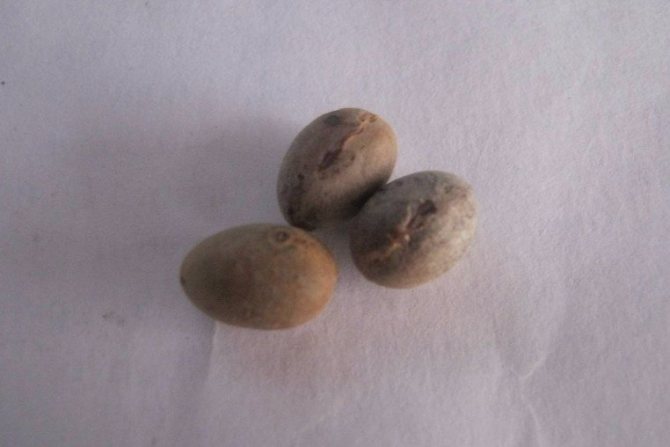

The seeds are suitable for planting for a year after harvest. It is best to plant in late winter or early spring. To speed up sprouting, you first need to carry out the scarification procedure - the destruction of the hard shell of the seed for quick access to the embryo. This can be done by mechanical (solid object), thermal (when freezing and scalding with boiling water), chemical (soaking the seed in an acid solution) methods. Next, the seeds must be soaked for 48 hours in warm water.
Learn more about the methods of pre-sowing seed treatment - scarification and stratification.
To prepare the soil, mix perlite, vermiculite and leafy earth in equal parts. The soil temperature should be warm, up to + 30 ° C, the soil should be abundantly moistened. The containers should be filled so that the top edge is 1.5 cm. After soaking, press the seeds into the ground by 1 cm, cover them with foil and place them in a place with sufficient light. Seedlings will appear within 1-4 months. The film must be removed daily and the containers must be ventilated for an hour.
Important! The soil must not be allowed to dry out during the period of seed growth! It is also very important not to overdo it with moisture, otherwise the seeds will rot.
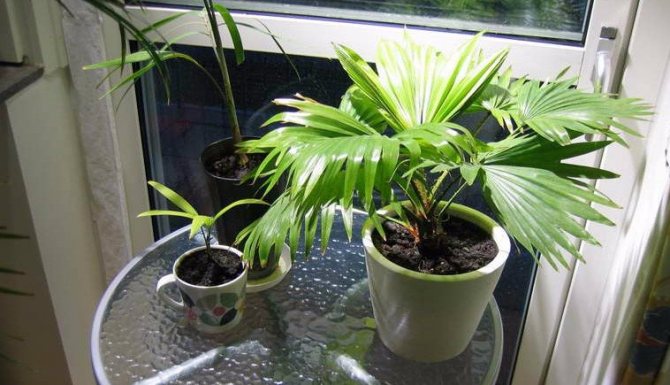

You can transplant the plant into a constant container when the seedling reaches 2-4 cm.When transplanting, you need to handle the roots as carefully as possible, leaving all the ground on them, if possible. The plant is accustomed to the greenhouse conditions under the film, so it should not be abruptly removed. It is necessary to increase the time without shelter daily: by 2 hours, then by 3 hours, bringing it to a day.
Difficulties in care and diseases of the liviston palm
- Lack of moisture, dry soil, low temperatures will lead to wilting of the leaves.
- Dry air will dry out the tips of the leaves. You need regular spraying on the leaves and the installation of a humidifier.
- Liviston is damaged by mealybugs, spider mites, scale insects, whiteflies - insecticides will save them.
If the Liviston palm dries
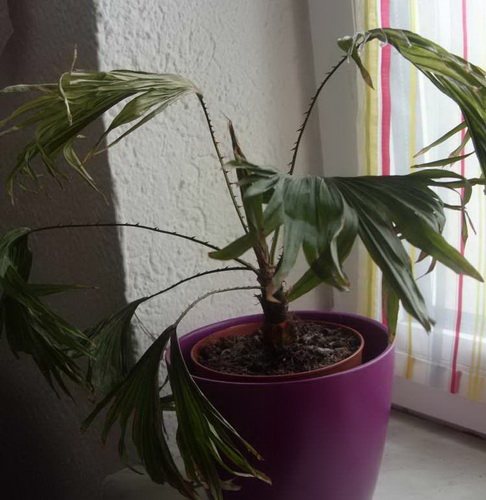

Liviston palm dries what to do how to treat
If the leaves of the Liviston palm tree dry, an urgent transplant is needed. The plant is sick and requires replacement of the contaminated soil plus fungicide treatment for root rot. Remember: you can only water the palm tree with warm water (so that the finger dipped in the water is warm) and regular spraying of the leaves. The soil should be moderately moist, with constant overflows, the plant will die.
Liviston also dries out from insufficient watering, excessive dryness of the air, too compacted soil.
Why do the leaves of the room palm liviston saribus turn black
Blackening of the leaves of the Liviston palm is a sign of root rot due to overflow. Damage to the roots is possible during overdrying, excessive concentrations of feeding, sometimes pets - cats and dogs - can "harm".
The palm can be helped by treatment with a biofungicide phytosporin and watering once a week with a biostimulant Zircon (concentration 4 drops per liter).
If this does not help, you will have to reanimate the plant with a transplant: it will be necessary to cut off almost all the leaves, leaving only the young ones, remove the soil from the roots and cut off all the sick. The palm tree is transplanted into fresh soil, the pot is disinfected. Watering should be regular and moderate.
For a diseased palm, additional illumination with a phytolamp is recommended for at least 12 hours a day.
Sowing preparatory stage
Store-bought palm seeds are usually already free from the pulp and fibers of the outer shells. But, sometimes unpeeled seeds are on sale, in fact, they fall into the hands of flower growers in this form when they are directly collected from a palm tree.
In these cases, before sowing, they must be cleaned of pulp, for this there are two good reasons:
- The procedure will prevent the material from rotting during germination.
- The pulp of palm seeds contains substances that slow down the process of germination of the embryo.
To remove all the pulp particles, it is recommended to place the seeds in a container with warm water for 2-3 hours, and then scrape off all the remains. Then, it is advisable to keep them for several hours in a fungicidal preparation, for example, Fitosporin. Since the seeds of many palms "sit" in the ground for a very long time before germination, such treatment will reduce the likelihood of their rotting.
The prepared material should be thoroughly rinsed and soaked in warm water for 1-2 days. Water should be regularly changed to fresh, warm water. The duration of the event depends on how fresh the seeds are and how thick their protective shell is.
You can also hold the seeds for 10-12 hours in a growth stimulant solution: Pennant, Epine, Zirkone. And then disinfect: dilute a few drops of chlorine bleach (Domestos, Belizna, etc.) in a liter of water and place the seeds in the liquid for 7-10 minutes.
After all the procedures have been completed, it is advisable to scarify seeds with thicker and stronger shells in order to accelerate their germination. To do this, one side of the seed is filed with a file or file.
An important point! It is important not to overdo it during scarification! If you damage the shell through and through, then later the kernel may rot.
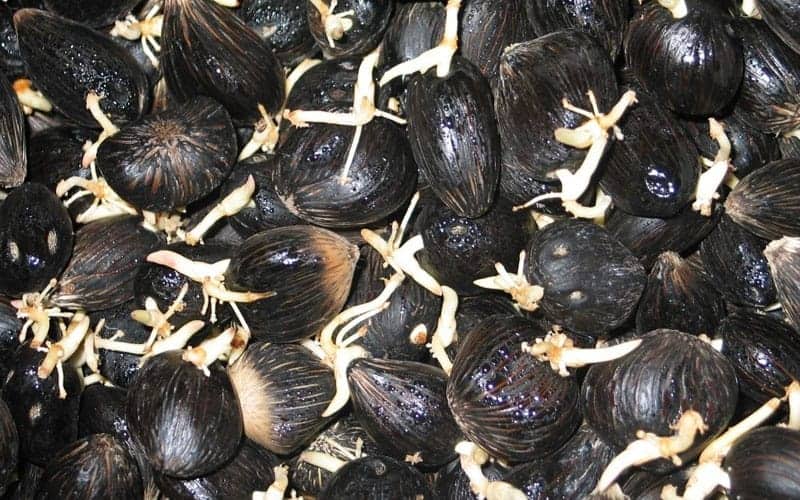

Types of Liviston palm with photos and names
Chinese Livistona Livistona chinensis
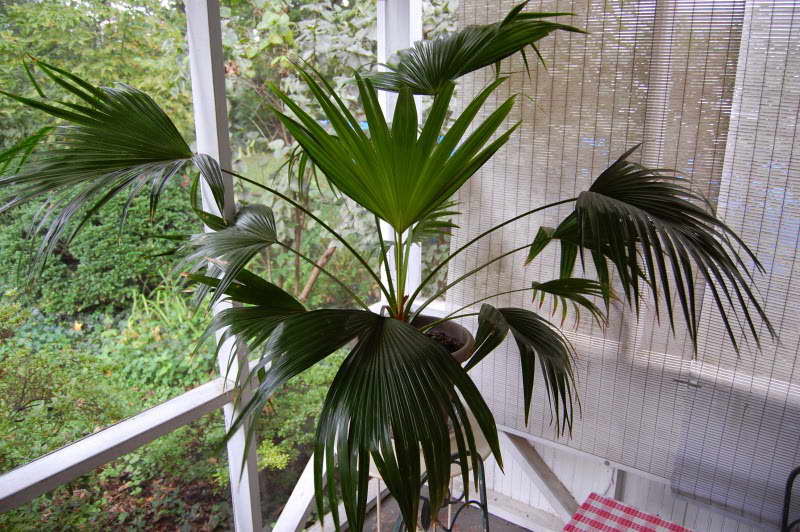

Chinese Livistona Livistona chinensis photo
The homeland is South China. The trunk, reaching a height of 10-12 m, a diameter of 40-50 cm, has a jagged surface in the lower part, the upper part is covered with fibers and remnants of dead leaves. Fan leaves split up to half into segments of 50-60 and up to 80 cm, with drooping, deeply incised, pointedly tapering ends. Meter petioles about 10 cm wide, tapering to the top by about 4 cm, the lower third up to the middle has pointed, short, straight thorns at the edges, which are pressed into the leaf plate up to 20 cm long, parchment-like edges about 1 cm wide, the tongue is raised, inflorescences are axillary. Grow in a moderately warm environment.
Livistona Round-leaved rotundifolia Livistona rotundifolia
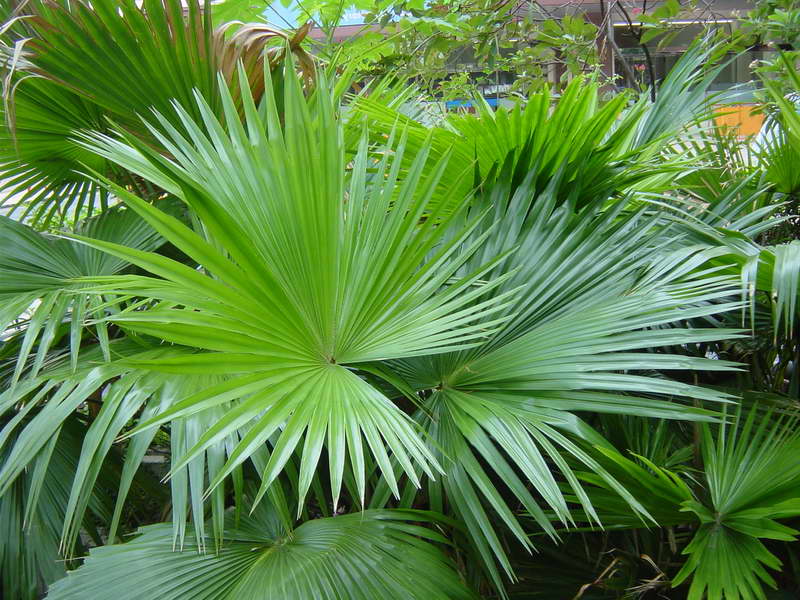

Livistona round-leaved care at home photo
Distributed in coastal areas on the sands of Java, the Mollux Islands. The height of the trunk is 10-14 m, the diameter is 15-17 cm.Fan-shaped rounded leaves reach a diameter of up to 1.5 cm, dissect 2/3 of their length into folded lobes. Green, glossy leaves extend evenly in a circle from the tops of the petiole. The petiole is up to 1.5 m long, densely covered with thorns along the edges and up to 1/3 of the length from the base. Inflorescences are long, axillary. Should be grown in moderately warm rooms.
Livistona saribus
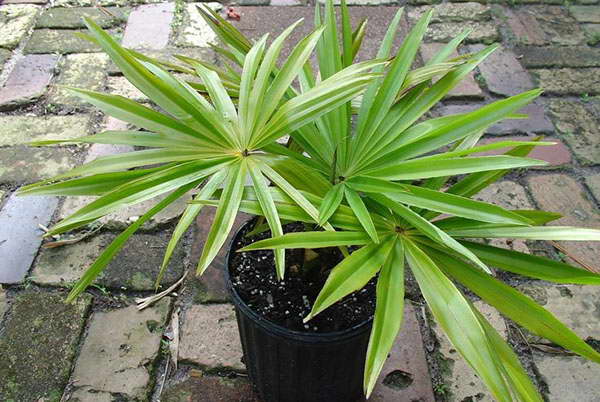

Livistona saribus photo
Livistona South or Australian Livistona australis
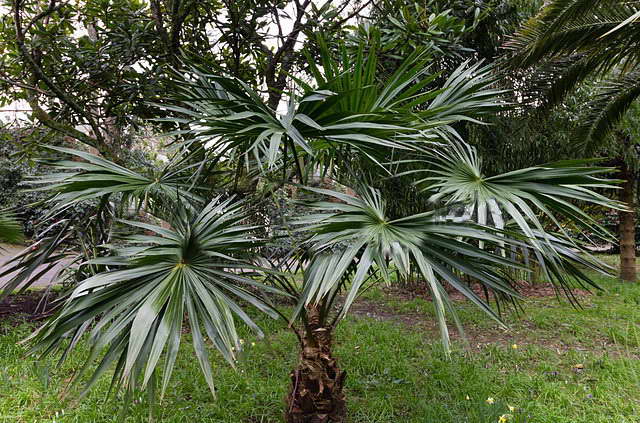

Livistona South or Australian Livistona australis photo
Prefers the humid subtropical forests of Eastern Australia, the range reaches the south of Melbourne. The columnar trunk reaches a height of 25 m, a diameter of 30-40 cm, thickened at the base, covered with scars. Fan leaves are glossy, dark green, 1.5-2 m in diameter, split into lobes (more than 60). Petioles 1.5-2 meters long are covered with frequent, strong, sharp, brownish thorns. Axillary inflorescence is branched. Loves partial shade, grows well in indoor conditions.
The fan palm of Liviston was difficult to find next to a person a hundred years ago. Capricious beauties were bred in equipped greenhouses and botanical gardens. Nowadays, an ornamental plant can be found both in a crowded office and inside a cozy apartment.
The genus of Liviston palm trees includes more than 35 representatives, but at home only three take root without problems. Tropical culture has little whims that are best to listen to. If you understand the rules for growing and caring for a tree, then it is easy to avoid common troubles.
Transplanting seedlings
As a rule, it is recommended to transplant seeds that have roots - each sprout into a separate reservoir. It is convenient to use plastic cups for these purposes, and large seeds can be immediately placed in small pots.
However, some are in no hurry to plant them and initially place the sprouted seeds in a damp cloth and spread them in a warm place where there is a lot of light. It is better to pre-treat them with a fungicidal agent. As soon as the seeds have 1.5-2 cm seedlings, they can be transferred to a separate tank.
The soil mixture is also better sent for sterilization or treated with fungicides.
If the "palm" has hatched in a container with another flower, then it is not so easy to remove it. To do this, you need to take out the plant together with a lump of earth, carefully take out the sprout and transplant it into a separate tank.
It is interesting! Practice shows that palms sprouted in "alien" pots are stronger and develop faster than their counterparts from the substrate.
Most palms experience a lot of stress during transplanting, so when working with the plant, the root system should be handled carefully to avoid damage.
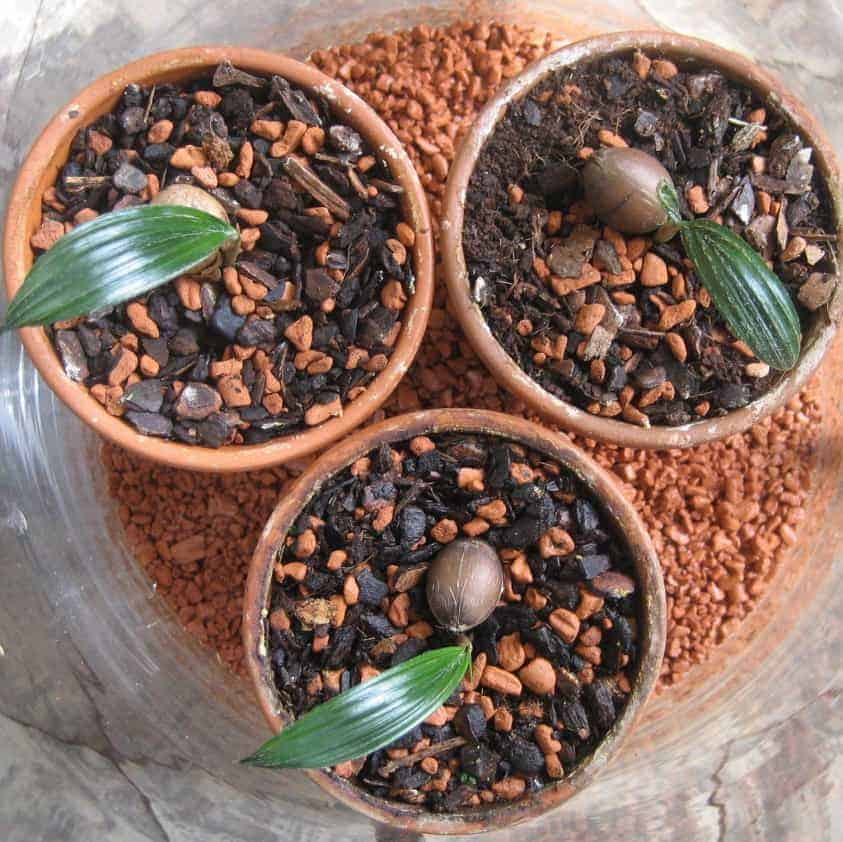

Species characteristics
The beautiful perennial was named after the Livingston laird, whose collection contained thousands of exotic plants. Elegant culture is found in the subtropics and tropics of Asia, Africa, Australia. In natural conditions, it lives along the banks of rivers and inside swampy forests, we prefer the Black Sea coast of the Caucasus.
In the wild, the Liviston palm grows up to 25 m in height. The thick trunk of the tree is covered with the remnants of the plates, and at the top it opens with a voluminous crown-cap. Fan-shaped glossy round leaves with cuts in the center reach 100 cm in diameter. Dark, sometimes with a gray bloom, petioles are covered with sharp teeth.
At home, the Liviston palm does not grow as actively as in its natural state. Indoors, the plant does not form a trunk, but grows due to greenery. If you choose the optimal care for the culture, then three leaf fans appear annually. The tree has a strong root system that provides stability in wet soil.
Palm can be grown at home
Planting a palm tree in a pot and growing it at home is the dream of many gardeners.Exotic plants attract a domestic person with their uniqueness, stature and beauty. There are several ways to grow these trees at home. One of the most simple and interesting is growing from seeds.
Every person who understands the peculiarities of planting and caring for such trees can grow a palm tree in a pot. In order for the plant to actively develop and delight the owner with its appearance, it is important to understand both the preparatory measures before planting and the care of this beautiful tree.
Popular varieties
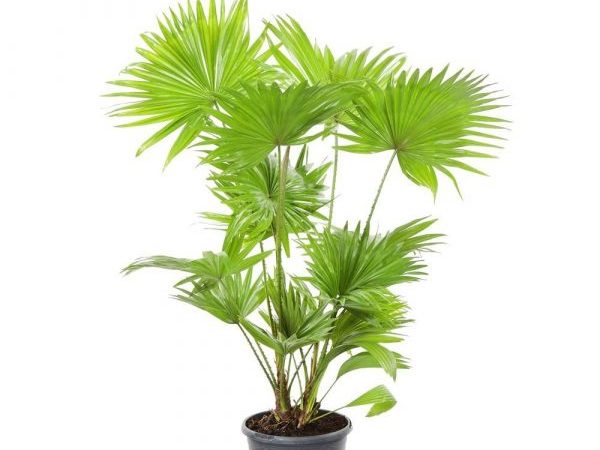

Palm LIvistona round-leaved or Rotundifolia Is a lush beauty native to the coastal area of Java. Huge dissected fan-shaped leaves reach 1.5 m in diameter and sharply turn into a one and a half meter spiny petiole. The decorative culture withstands home conditions, a moderate office microclimate.
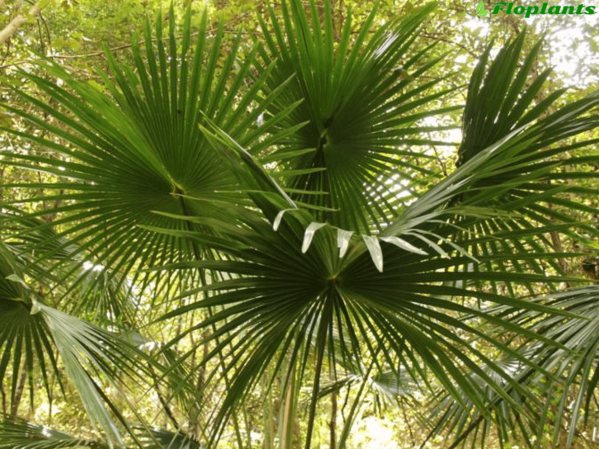

South Livistona grows in nature in the humid forests of Australia, therefore it received its second name - Australis. The plant has a massive columnar trunk up to 25 m and 30 cm in diameter. The tree has folded glossy webs with splitting into pieces, growing in scope up to half a meter. Culture prefers to develop in greenhouses, in people's homes.
Sowing seeds
Sowing seeds can be done at any time of the year. For sowing, flower soil is suitable. Fill a 500 ml pot with soil and plant several seeds in each to a depth of 3 cm. The interval between seeds should be 4 cm. After planting, the soil is moistened. To create greenhouse conditions, the pot is covered with polyethylene and placed in a warm, well-lit room. Every day, the polyethylene must be removed to ventilate the seedlings. The soil must be kept constantly moist.
Germination of seeds is a long process and takes from four weeks to six months. If the seeds germinate in winter, then the pot must be placed next to the battery. The temperature for germination of sprouts must be above 25 degrees.
Read more: Forcing tulips at home
Lighting should be diffused. Duration of daylight hours is not less than 10-12 hours a day.
Growing conditions
Lighting and location
Livistona is a light-loving plant that hates direct ultraviolet light. At home, in spring and summer, it is better to install the pot near the east or west window, and in winter the tree withstands the southern direction. To protect against burns, you need to shade at noon. The culture prefers to thrive at moderate temperatures. The species requirements vary from one season to the next:
- Winter. Comfortable are + 16-18 C, but not lower than +10 C.
- Summer. Optimum indicators + 24-29 C.
With the onset of autumn, the intensity of illumination decreases, which slows down the internal processes in the Liviston palm. Plants with a formed trunk can withstand a couple of hours at frost down to -5 C. In hot weather, flowerpots are placed on a balcony, loggia, not in direct sunlight. The tree loves fresh air, but does not tolerate cold streams from the air conditioner, a draft from the window. During the heating period, the content of the batteries is contraindicated for the species.
Watering
Home care for Liviston is to maintain optimal humidity. In summer, the plant is watered abundantly, and from autumn the amount of liquid is gradually reduced. Remains of water from the pan must be removed after two hours. In winter, irrigation of the tree is carried out as the top layer of soil inside the tub dries out, but do not allow it to dry out to the bottom. Regularly, the leaves are wiped with a wet sponge, daily sprayed from a fine spray bottle.
Top dressing
During active growth (April-September), the Liviston palm needs additional feeding. With a deficiency of nutrients, the plant at home slows down development, poorly grows leaves.In spring and summer, applications are carried out every ten days, and from autumn the number of procedures is gradually reduced to once a month. For fertilizing a tree, preparations are suitable:
- complex for indoor palms;
- universal for ornamental crops;
- organic from the "Gumi" series.
Transfer
Young seedlings are transplanted once a year, and adult plants do not disturb more often for 3-5 years. Livistona does not like frequent procedures, so growers advise using the transshipment method. At home, the event is carried out during the growing season of the species - from the end of February to August. The substrate is independently collected from nutrient soil with the addition of sand, charcoal. A thick layer of drainage must be poured onto the bottom of the volumetric pot.
Planting process
Even an inexperienced grower can plant a palm tree, however, a number of important nuances should be taken into account. First of all, palms are somewhat different from most home flowers, which means they have their own special needs:
- you can sow palm trees regardless of the season, however, sprouts need a well-lit place; with a lack of light, they will have to be provided with artificial lighting;
- germination and germination duration are related to the shelf life of the seed, so it is better to sow it immediately after purchase;
- prepared seeds are placed in a light soil mixture - this can be a ready-made material for germinating seeds, in addition, flower growers often use a mixture of perlite and vermiculite, with the addition of sphagnum or a substrate of coconut fibers; they should be moist, but not wet; it is advisable to pre-disinfect the material by steaming for 8-12 minutes in the microwave;
- it is not necessary to place the seeds too deeply, a depth of 1-2 diameters of seeds is enough; if too deep, they begin to rot; if the seeds are scarified, then they should be planted with the cut side down;
It is important! Vermiculite and coconut substrate are capable of absorbing moisture in large quantities, which can harm the seeds. Therefore, for beginners who do not have experience in growing palm trees, it is better to start with the use of special ready-made formulations.
- you can take any container, but it is best to use containers made of transparent plastic with a lid - in these, confectionery and pastries are sold; in a closed container, the seeds will not dry out, and thanks to the transparent bottom, it is easier to observe the process of seedling growth;
- the landing should be placed in a warm place, the air temperature should be + 25- + 32 degrees; however, this figure depends on the variety of palm trees: for some, the normal germination temperature is +25 degrees, while for others, +30 is not enough;
- to eliminate the likelihood of mold formation and rotting of seeds, you should arrange daily ventilation - it is enough to open the container lid for 15–20 minutes a day, providing free air access;
- home-grown palm seeds do not need to be watered; as the substrate dries, it should be carefully sprayed from a spray bottle;
An important nuance! In the heating season, containers with planting can be placed on the battery, only by placing a wooden board between them. But, in this case, it is necessary to regularly measure the temperature of the substrate. If the thermometer shows that it is very high, the seeds can literally "cook"!
Some, especially advanced "palmaholics" purchase special mini-greenhouses with installed heating devices and a thermostat. But, this pleasure is not cheap.
In the summer, a container with palm seeds can be put on the windowsill, but you just have to take into account the following:
- the windowsill should be warm, without drafts and constant shade;
- the substrate and seedlings should not be exposed to direct sunlight.
If there is no place with suitable conditions, then there is a way out: future palm trees will feel good on a cabinet, where the thermometer will always show more degrees than in other parts of the room.
Note! For best results, you can plant a few seeds in homemade flower pots. They will sit in the ground longer, but in such conditions their germination increases.
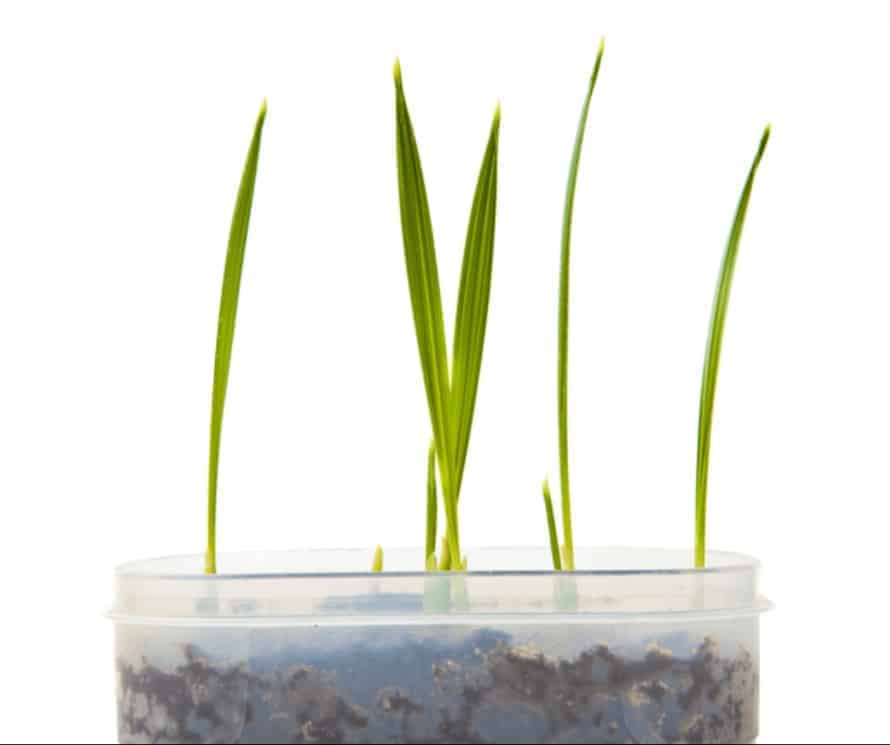

Breeding rules
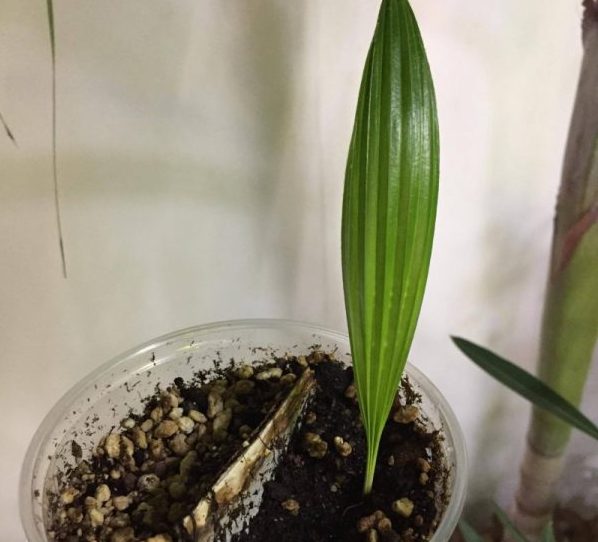

Sowing is an easy way to get a new Livistona palm at home. Seed material is purchased in specialized stores or from breeders. The storage duration of the grains negatively affects the germination of the plant, therefore, they do not buy raw materials packed more than a year ago. Florists recommend planting the future tree in early to mid-spring.
To improve pecking, the seeds are soaked in warm water. The container is left for a week under comfortable conditions (within 25-30 C) for awakening. Every day, the liquid is changed to fresh. 24 hours before sowing, the material is treated in a mixture of fungicide ("Maxim Dachnik", "Fitosporin") and growth activator "Epin".
To plant a palm tree, Livistons at home take separate plastic cups or a volumetric container. Ready-made potting soil is suitable. Adding to the composition will help improve the breathability of the substrate:
- charcoal;
- small expanded clay;
- river sand.
In the heated moist soil, small holes (1-2 cm) are made with a finger, into which the prepared grains are sown. Gently sprayed from above with a spray bottle, put on a sunny warm windowsill. To provide plants with a natural "tropical" microclimate, the beds are covered with glass or transparent polyethylene. Every day the crops are aired and moistened. If the conditions are right, then the first shoots will appear in 2-3 months.
Seedlings develop without problems on the windowsill. Caring for a Liviston palm tree at home consists in regular watering, loosening and ensuring suitable temperature indicators. Comfortable for a tree is the limit from +24 to +29 degrees. Daylight hours should last at least 12 hours. If there is no sun, then the plants are illuminated with a phytolamp. Mineral complex dressings are applied once a week, after abundant irrigation. To prevent root rotting, the soil is treated with a fungicide every 30 days.
Seedlings grow slowly, so diving into separate or large pots is carried out after two adult leaves appear. The formed form of Liviston will acquire in three years. Transplanted into other containers as the roots grow. If the underground parts are tightly entwined with the free space and are visible to the naked eye, then it is worth transferring to a new flowerpot.
How to plant and how to grow such a beautiful Liviston palm from seeds?
Plants of the Livistona family are propagated by seeds, which can be purchased at a specialized store. Before planting, the seeds must first be kept in filtered water for 24 hours, after which they are placed in a hole in the ground 1 cm deep.
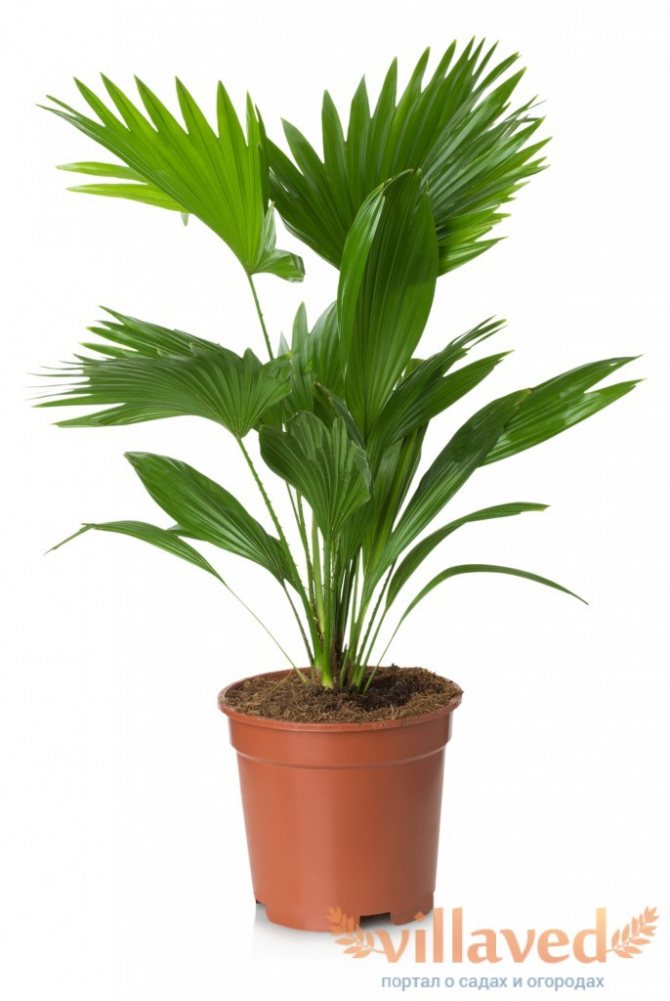

Livistona round-leaved in a pot
Soil for planting livistons
An adult Liviston plant is planted in a nutritious soil mixed from 3 types of soil:
- Humus.
- Leafy land.
- Turf.
For young animals, you can use a lightweight version:
- 30% peat.
- 40% humus.
- 30% pure sand.
Under the soil, be sure to drain the stones, so the water will not stagnate, and the air circulates better. As a last resort, make 5-6 small holes in the bottom of the pot, of course, plastic.
Frequent problems
Failure to comply with the minimum care rules leads to a weakening of the Liviston palm. The tree is equally sensitive to both excess irrigation and moisture deficit.The plant reacts to a short drying of the substrate by changing the color of the leaves, further dying off of the greenery. Regular stagnation of water at the roots, especially in winter, leads to decay. To avoid mistakes, you must carefully monitor the moisture content of the earthen coma.
In summer, light brown spots spread over the plates. Ugly defects leave bright rays of the sun. It is no longer possible to get rid of them, therefore it is better to prevent the appearance in advance and rearrange the flowerpot with the culture further from ultraviolet radiation. At home, with a lack of lighting, cold, the Liviston palm stops growing, the lower tier becomes discolored.
Errors in grooming are manifested in the appearance of the plant. Bronze markings on foliage are a symptom of a lack of potassium, and faded greens occur in the absence of nitrogen. An excess of mineral fertilizers is toxic to plants, especially to young, weakened ones. Poisoning manifests itself in the form of dry tips and sharp wilting.
Yellowed leaves spoil the decorative effect of the palm, but you should not immediately cut off the ugly parts. At home, culture gradually "draws" useful trace elements from the plates, after which it dries out the unnecessary organ. If the defect is removed, then Livistona will continue to look for fertilizers in fresh greenery.
Exotic plant for home
Of course, for the time being, palm trees are inferior in popularity to more traditional home vegetation - violets and geraniums. In part, this is due to common biased judgments:
- these trees are too large for apartment maintenance;
- they grow too slowly - taking a shoot, only our grandchildren will be able to admire an adult plant;
- to grow a palm tree as a houseplant, it takes a lot of knowledge, effort and time - an inexperienced florist cannot afford this task;
- living conditions for these tropical guests are absolutely not suitable.
However, most of the above are common misconceptions. From the variety of palm trees suitable for growing in housing, you can choose the most suitable "pet", while he will feel no worse than in his native tropics. When choosing, you should focus on 3 main factors:
- the complexity of germination and care;
- appearance - nevertheless, the plant should harmoniously fit into the interior;
- the size of an adult palm.
Ideal for a small room: hamedorea elegance (she is elegant); chrysalidocarpus and date palm. The last option is considered the most economical: you can get seed on your own by buying dates in the store and leaving their seeds.
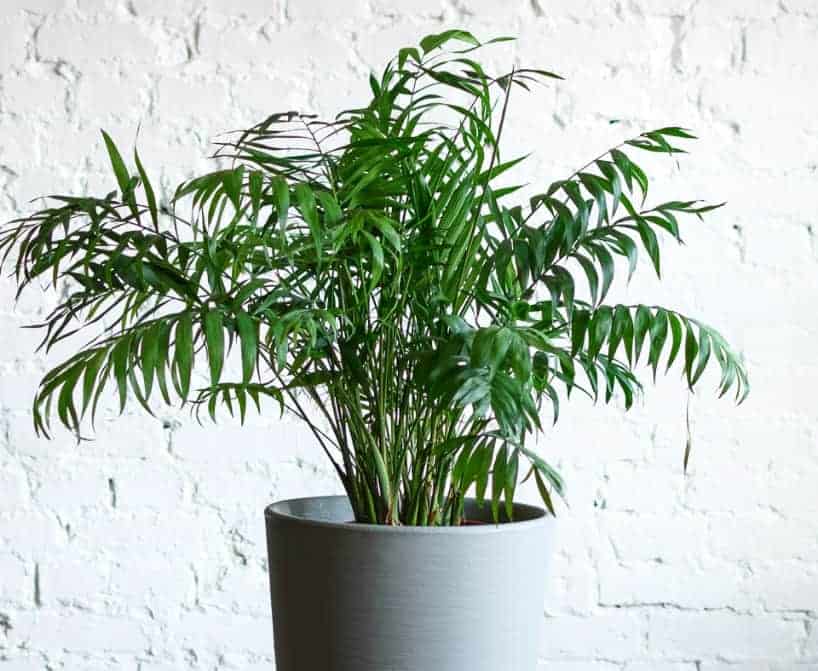

If the florist is the happy owner of high ceilings and the height of 2.5 m is not the limit, you should take a closer look at the taller and more imposing palm trees:
- Livistone Chinese (patching);
- Hamerops;
- Washington and the thread.
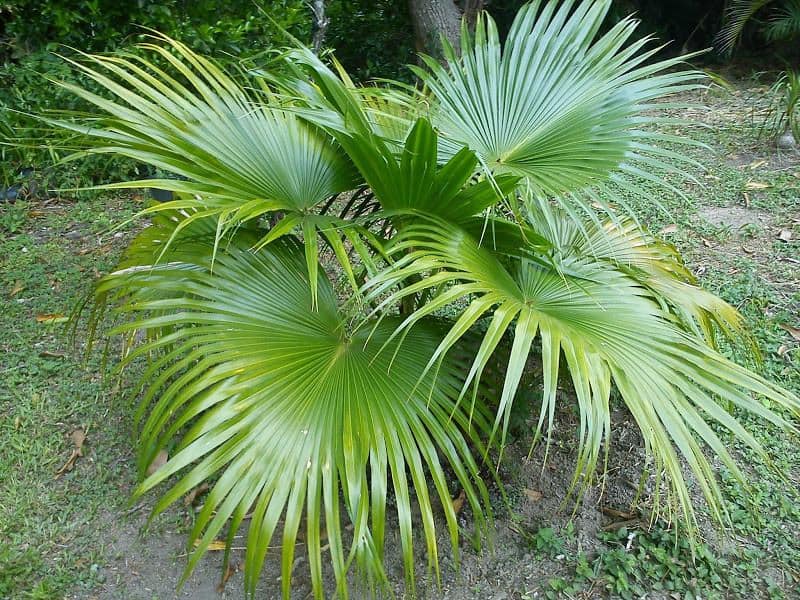

Chinese Livistona
Amateurs say that it is easier to buy an adult plant, however, it is much more interesting to grow a palm tree yourself - from scratch, more precisely, from a tiny seed. For many peoples, the palm branch is a significant symbol:
- since ancient times, the Chinese believed that it symbolized dignity and fertility;
- in the Arabian Peninsula, the palm is considered the tree of life;
- for Christians, the palm branch is a symbol of eternal life, divine blessing and the biblical garden of paradise;
- for early Catholicism, it was a funeral symbolism.
Today the branch of the tree is found on the coats of arms of many states: Bolivia, Cuba, Cyprus, Sierra Leone and others. Here she talks about the country's territorial location and economic priorities.
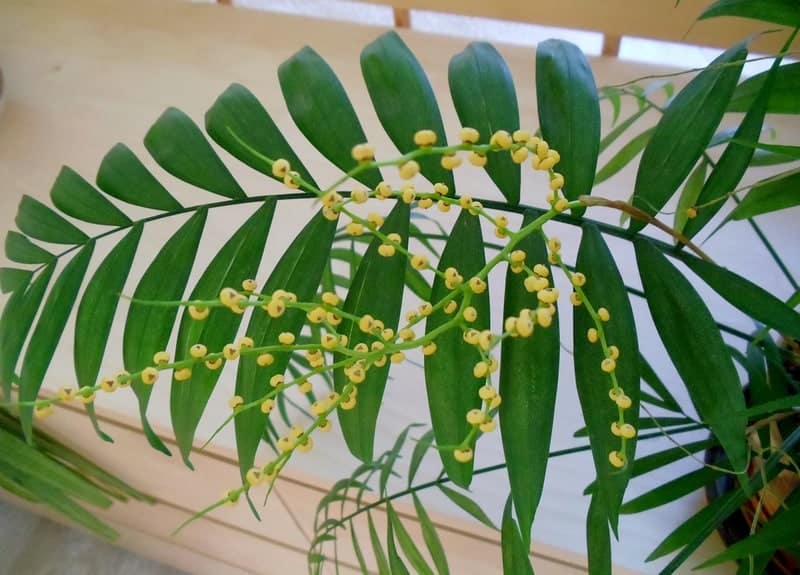

Diseases and pests
The tropical palm tree has strong immunity, so it rarely gets sick. A common plant disease is a fungus that occurs inside wet soil in case of care errors (cold, poor lighting). The disease manifests itself in the form of wilting and lightening of the foliage.At home, treatment begins with a complete replacement of the substrate, disinfection of the pot, and irrigation with fungicides.
Livistona is resistant to insects, but in heat it often suffers from mealybugs, ticks and scale insects. Pests suck out the intercellular fluid from the foliage, as a result of which the culture is weakened and sick. In order to prevent the death of the tree, it is necessary to immediately begin to destroy it. Systemic preparations of intestinal action (Aktara) are used, alternating with Fitoverm and Akarin.
Livistona is a recognizable palm tree that will naturally fit into the interior of the room. By following the minimum care requirements, it is easy to achieve rapid development at home. The grateful beauty will delight you with her magnificent view for decades.
How to get seeds - high quality and fresh?
Good seed is what you need to grow a palm tree from seeds, but where to get it, and most importantly, how to distinguish a quality product from an illiquid product?
Where can you buy seeds?
The most common way to purchase seed material is through the online store. Here you can encounter an incredible abundance, find seeds of the rarest species, and also get useful information.
However, Russian flower growers use more inventive options. For example, take seeds where palm trees grow in their natural environment. And in order to get to the "warm lands" in time, you should plan your trip in advance. Moreover, many palm trees grow not so far, they can be found on the streets of the Crimea or the Caucasus.
Well, the third option is to eat dates and leave the seeds - it's easy to get a plant from them at home. And besides, children can be involved in this process - that's who will rejoice at the emerging sprout more than the florist himself!
Freshness of seeds
Naturally, when buying seeds, you should pay attention to their freshness. In most species, germination depends on this property. However, there are exceptions - palm seeds, which grow in arid regions, can be dormant for a long time, waiting for the right moment.
It is interesting! The seeds of the Washingtonia palm tree, which prefers to grow in the desert, remain viable for more than ten years. They germinate as soon as they get in favorable conditions, but sometimes they have to wait for a long time.
When buying, you can be guided by the fact that the collection of seeds of plants of the northern hemisphere is carried out most often in late autumn and early winter. The material of the southern hemisphere palms is collected in May - June. So, if during these periods the catalog of the online store was replenished with new products - most likely, these are fresh, viable seeds.
Maturity of palm seeds
In addition, you need to know how to distinguish between mature and immature seeds. The softness of the cotyledons is a sign of immaturity. The shell should be dark: brown, reddish, black, but not green.
Palm trees differ, some have 100% germination and the first shoots appear quite quickly, while others can sit in the ground for a very long time, germinating extremely slowly.
Some shops offer already sprouted palm seed for sale. In this case, you can buy as many seeds as you need, without thinking "what if they don't sprout."
If it is a dream to grow a palm tree on your own, and only ordinary seeds are on sale, then, in order not to be disappointed, experienced palm experts advise taking at least 10 pieces, or better - 2-3 dozen, which will increase the chances of a positive result.
But, it is not enough to become the owner of seeds, it is also worth getting acquainted with the peculiarities of growing a palm tree from seeds - how to prepare, plant and care for?
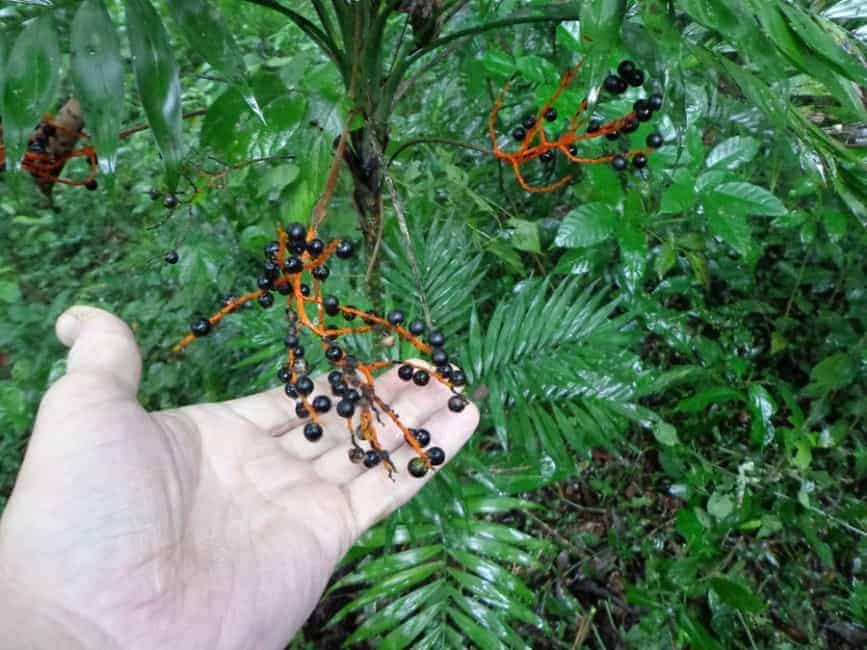

Trachikarpus in the open field
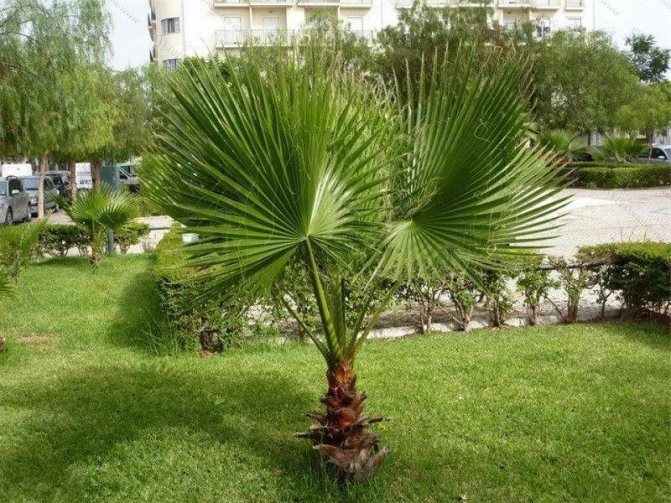

Palma trachikarpus growing in the garden photo
Frost resistance
The maximum negative temperature that the trachycarpus can withstand is -15 ° C.If your region has a mild climate and mild winter frosts, trachycarpus can be grown outdoors in the garden.
Trachikarpus, in comparison with other types of palm trees, prefers cooler, temperate regions: in the subtropics, the palm tree will actively develop, but it will feel uncomfortable in the tropics. This plant can easily withstand slight frosts. In its natural habitat, the palm is sometimes covered with snow and ice. Seedlings are planted in places protected from the wind. Young plants are less hardy and can be damaged by frost at -8 ° C. Very young plants need shelter during the first or two winters outdoors.
Where to drop trachikarpus
Sunny protected areas are chosen for planting, especially from cold dry winds in the north and east in temperate zones, or partial partial shade in subtropical zones.
This palm is moderately salt tolerant and can be planted in sheltered areas where the sea breeze is not directly affected. Protection from harsh winds will minimize leaf breakage and allow this palm to look its best. Individual leaves live for about three years if they are not damaged by the wind.
Soil composition and how to root
Trachikarpus forchuna prefers depleted soils with an average humus content, but will survive in almost all cases, except for areas with stagnant moisture.
Fortune palms have deeply penetrating root systems and usually root best when they are young. Therefore, in areas that are at the limit of their winter hardiness, it is reasonable to grow plants in containers for several years, giving them winter protection, and planted in a permanent place only when they reach very large sizes. Plant them outdoors in late spring or early summer, after the last expected frost.
These palms can also be replanted even when they are very large. Although the thick, fleshy roots are easily damaged and / or dried out, new roots usually reproduce quite quickly.
How to transplant trachycarpus fortune in the open field, we look at the video:
Watering and feeding
Watering is required regular, but no frills. Create a small hole around the plants to retain water for longer. Mulching protects the small roots of the palm tree from drying out. Trachikarpus forchuna tolerates short periods of drought relatively easily.
Trachycarpus should be fed regularly with palm fertilizers, strictly following the manufacturer's instructions.
Useful properties of trachycarpus
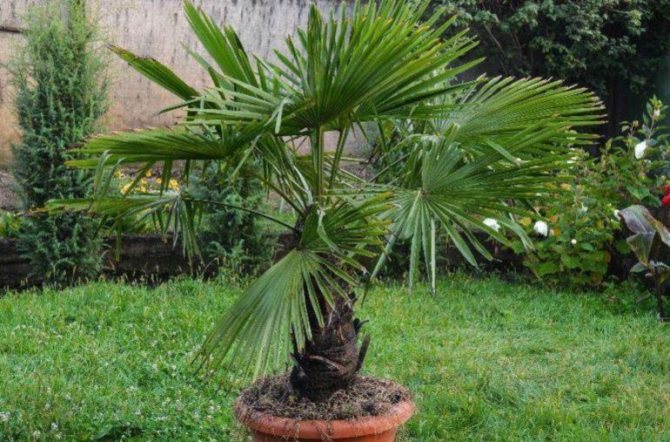

Trachikarpus Fortune. Photo
The plant is not only beautiful - it is known as an active air purifier. The palm tree filters it, freeing it from formaldehyde. Varnish applied to furniture emits harmful fumes even at room temperature. Trachikarpus Fortune successfully neutralizes not only them, but also trichlorethylene and benzene compounds.
The sharp edges of the leaves ionize the air and act as an oxygen generator.
For a good microclimate, experts recommend placing a palm tree in a living room, and it will continuously fill the room with oxygen throughout the day.
Botanical description
Trachycarpus (Trachycarpus) is a bright representative of the Arecaceae or Palm family. According to various sources, the genus has 6-9 species, most often Trachycarpus fortunei is cultivated. Let's take a closer look at the description of the plant. In the natural environment (tropics of East Asia, Japan, China, Burma, Himalayas), Fortune's trachycarpus reaches a height of 12-20 m. Growing indoors, one should not be afraid that the palm tree will "grow" to the ceiling - the height will be no more than 2.5, and the annual the gain is small.
Due to its resistance to cold (it can withstand temperatures down to -10 ° C), it can also be grown outdoors in warm regions (trachycarpus is common on the Black Sea coast of the Caucasus, Crimea).The street palm is able to reach its natural size after 12-15 years.
The trunk of the trachycarpus is erect, it is covered with dry hairy fibers that remain after the leaves die off. The palm tree is fan. The leaf plate is attached on a long petiole, it is divided into belt-like segments, the slit is almost to the base. The petiole may be spiked. The outlines of the leaf blade are rounded, the diameter reaches 60 cm. The reverse side of the leaves is covered with a bluish bloom, which is easily erased upon contact.
Trachikarpus looks most impressive in large rooms - offices, halls, conservatories, greenhouses, but nothing prevents you from creating a piece of the tropics in the room. Each plant needs care, and trachycarpus requires a more attentive attitude towards itself. It is worth studying the recommendations for growing, adapting and everything will certainly work out. By the way, the Liviston palm is less whimsical to care for.
1. Seven Secrets of Success:
| 1. Growing temperature: Livistona is thermophilic and must be grown at room temperature between 18 and 24 ° C throughout the year. |
| 2. Lighting: direct sunlight in the evening and morning, in autumn and winter maximum light. In the daytime in spring and summer, it is necessary to organize shading from the scorching sun. |
| 3. Watering and humidity: between watering, dry the soil to a depth of 2 - 3 cm. in spring and summer, in winter the frequency of watering is slightly reduced. Air humidity is high. |
| 4. Pruning: only sanitary - cut off the old yellow leaves, which from time to time will appear at the base of the crown of the palm tree. |
| 5. Priming: perfectly drained, nutritious, neutral or slightly acidic substrate, perfectly permeable to moisture and air to the roots. |
| 6. Top dressing: in spring and summer with liquid mineral fertilizers for palms. In the fall, the frequency of feeding is gradually reduced to naught, and in the winter months, Liviston is not fed. |
| 7. Reproduction: seeded, develops slowly. |
Botanical name: Livistona.
Family... Areca or palm trees.
Liviston palm - origin... Australia, China, Japan, Taiwan and India.
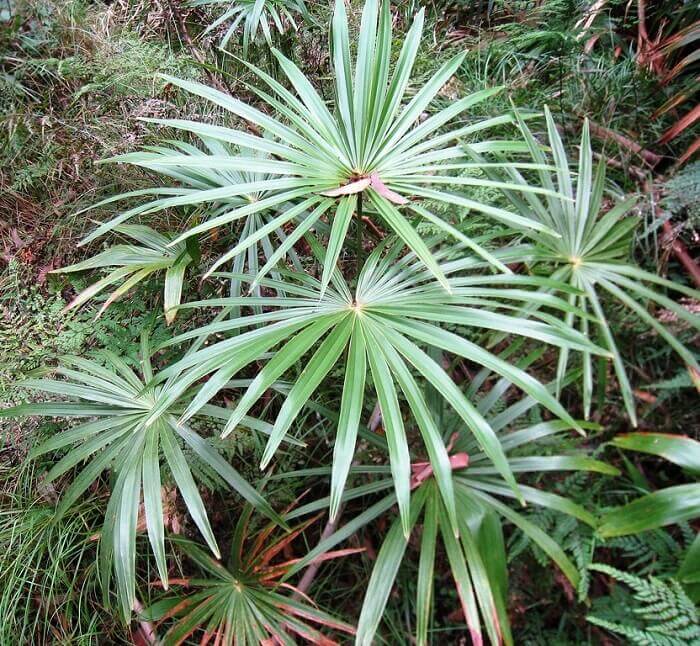

Description... The genus "Livistona" contains about 30 plant species. This is a graceful fan palm. The trunk, which forms in its natural habitat, is rough, brown in color, up to 20 cm in diameter, bears the remains of fallen leaves. When grown in indoor culture, plants do not always form a trunk and their leaves may appear directly from the ground. The leaves are large - up to 1 m in diameter, green, fan-shaped, on long, thorny petioles - up to 180 cm, each leaf is divided into 50 - 90 segments. The leaf segments are glossy, about 3 cm wide and 40-60 cm long. The flowers are collected in large, branched inflorescences up to 120 cm long, small - up to 3 mm in diameter, pink, cream or white. After flowering, rounded fruits with a diameter of up to 2.5 cm are formed.


Height... Young plants are kept in culture, Livistona grows slowly and reaches 1 m in a tub.
Palm sprout care
Palm trees grow in the tropics, with its inherent high humidity and air temperature. Therefore, the gardener must:
- Control soil moisture. It should be sprayed daily to avoid overflow.
- Keep the temperature between 24-27 ° C. This indicator is most suitable for active plant growth.
- Provide diffused light up to 12 hours a day.
When the sprouts reach 4 cm in height, you can start transplanting to a permanent growing site. From that moment on, they can be systematically watered with warm water and fed with mineral fertilizers every 2 weeks.
How to buy a palm tree
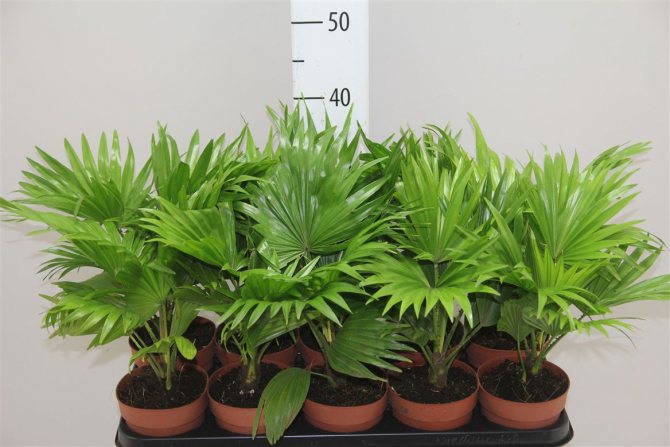

In a flower shop, you should opt for a plant with leaves of rich green light, and it must also have a young growth. Palm trees, the leaves of which have brownish tips or spots, it is better not to buy.
In the event that the purchased plant is in a small plastic pot, then it must be transplanted as soon as possible, since this is a shipping container.
Florists give different advice, which contradict each other. So, some say that this palm tree should be transplanted into a new container immediately after purchase, as it will better endure stress from both moving and transplanting. Others advise, on the contrary, to leave the newly purchased plant alone for 1–1.5 months, and after this time, carry out a transplant.
Liviston. Growing problems:
- Brown leaf tips a fairly common problem that occurs due to low air humidity. It is necessary to spray the plant more often.
- Yellow foliage occurs due to insufficient watering, an excess of sunlight and a lack of nutrients in the soil.
- Brown spots on the leaves appear when the soil is waterlogged, a sudden drop in the temperature of the content, and also if irrigation is carried out with poor-quality hard water.
- Brown leaf tips occurs due to lack of moisture, dry air and cold content.
- Stopping growth occurs when there is a lack of nutrients in the soil.
- Leaf spot occurs with insufficient watering.
Views: 441
Transplant features
Liviston is transplanted every few years, in spring, when roots appear on the surface of the earth or from drainage hole in the pot. The container is taken larger than the previous one, by 3-4 cm.
Important! It is better to buy a vase that is light (not so hot from the sun's rays) and high, always with a drainage hole. A drainage layer of pebbles or expanded clay, 4-5 cm thick, is laid at the bottom.
Transplanted in a coma of earth, removing rotten or diseased roots. When buying a palm tree in a store transplanting it into normal soil for growing is required.
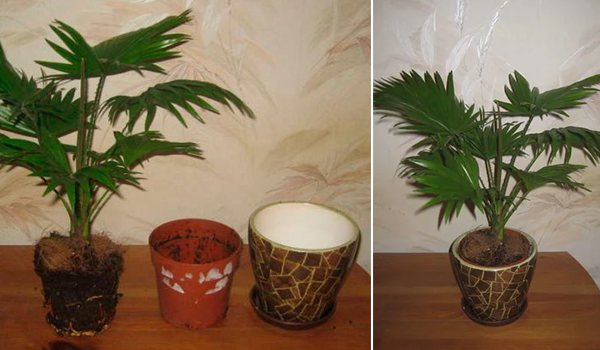

Reproduction of a palm tree by dividing a bush
It is best to perform the division procedure in May, when transplanting a bush. It is necessary to separate the lateral branch up to 25 cm high. Such a branch will be easier to root. The scion must have its own roots, flexible stems and a mature branch.
An adult plant gets out of the pot, and gently shake off the soil from the roots. Carefully cut the connecting roots using a sharp processed knife. The cut must be done as close as possible to the adult plant. Slices must be sprinkled with powdered charcoal.
Pour soil into a pot of small volume, prepared in the following proportion:
- sod land - 1 part;
- perlite - 2 parts;
- humus leaf - 2 parts.
We plant a young plant in the prepared soil, water it and place it for rooting in a room with a temperature of 32-35 degrees. If the temperature in the room is below the required one, then a frame is made of wire and a plastic bag is put on it. The bag is removed daily to ventilate the seedling and check soil moisture.
When the top layer dries, water the plant sparingly. Excessive moisture and stagnation of water in the soil are not permissible. This can lead to root rot. If a greenhouse is not installed over a young plant, then it must be irrigated daily with a spray bottle with warm, settled water.
An adult plant is planted after dividing in the same soil as a young one.
Difficulties encountered and their solution
Negative changes in the appearance of the plant are warning signs of improper care. For example, at low temperatures and low illumination, a plant may develop chlorosis.
From rare watering, palm leaves dry up. If the regime is not restored in time, the plant may die. Low moisture content leads to drying out of the tips of the leaves.
Solving these problems is simple: just set up the correct care for the palm tree and observe the necessary parameters.If the plant is attacked by pests or it gets sick, drastic measures are needed.
Pests
Dangerous insects can get on a new flower from other already infected indoor plants. How to deal with them:
- Spider mite can be identified by white spots and thin cobwebs on the bottom of the leaf plate. They use acaricidal drugs against it ("Demitan", "Talstar", "Fitoferm"). It is recommended to start treatment with pretreating the leaves with soapy water.
- Shield can be identified by sticky and raised spots on the leaves. Insecticides help to destroy the insect ("Actellik", "Inta-Vir"). First, you need to collect the pests from the leaves with a napkin, then wipe all the leaves with a cotton swab dipped in alcohol. After that, carry out the treatment with the named drugs.
- Mealybug inhabits the leaf sinuses, filling them and the trunk with a whitish bloom. The pest can be removed by wiping the affected areas with soapy water and subsequent treatment with insecticides (Inta-Vir, Talstar, Aktellik).
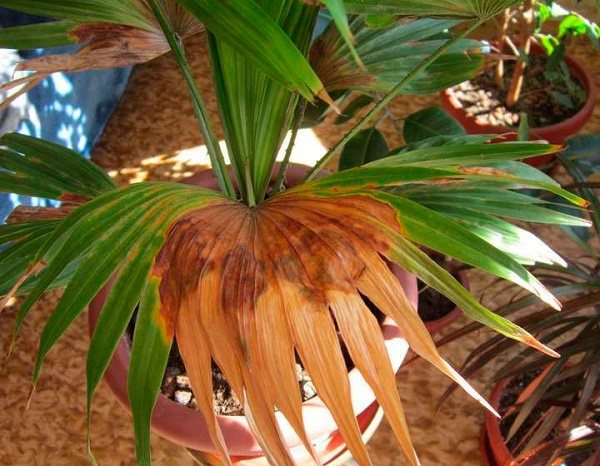

Diseases
Despite its high resistance to bacterial and viral diseases, Liviston can get sick with root rot, spotting, sclerotinia. All these diseases are fungal in nature. Fungicides with which the plant is treated help to cope with them.
Pruning features
The palm tree has only one point of growth - at the top of the stem, and therefore the palm is not shortened... Only completely dried leaves with cuttings are removed (broken off).
Important! Leaves are cut off only when the stalks are dried.
Drying of the tips of the leaves of Livistona is its peculiarity; they do not need to be cut off. If the endings of the leaves dried up significantly, and lost their decorative appearance, neat trimming of yellowed tips is allowed. Drying of the leaves continues - it is necessary to look for the cause.
This video tells about the peculiarities of caring for palm trees and how to plant this evergreen beauty.
What is this plant
Palm is the oldest plant, as evidenced by archaeological finds. The tropics and subtropics are considered the homeland of this plant; it multiplied in America, Africa, China, Japan, on the islands. It is a tree with a smooth trunk up to 1 meter thick without branches. She has a spreading crown with wide leaves of two types: fan-shaped and pinnate. In the wild, trees can reach 9 meters in height, in an apartment it is possible to grow a tree up to 2 meters high.
This tropical plant performs decorative functions in urban apartments. Careful grooming is essential to maintain vitality.
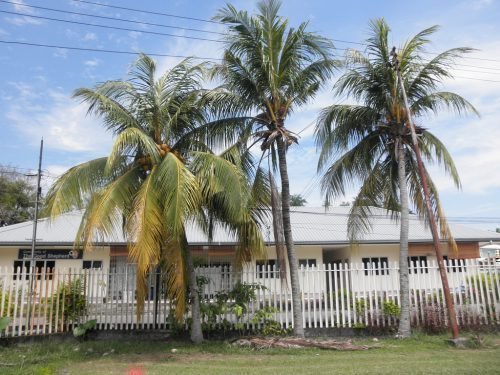

Palm trees are tall plants
Description
Its very original large leaves that look like umbrellas. They can grow up to 50-90 centimeters long and about 40 centimeters wide. They are green and have the shape of longitudinal, thin leaves merged with each other, the ends of which hang freely, forming characteristic "claws". Umbrella, semicircular leaves grow on long, rigid petioles covered with small thorns, which are connected at the base with a rough root zone. All this looks very picturesque, mentally bringing closer the hot, seaside beaches in exotic countries. Due to the shape of the leaves, the plant is sometimes also called chinese palm.
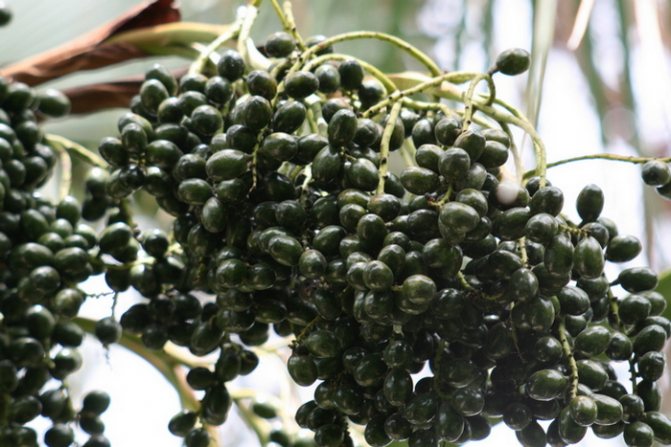

Breeding livistons
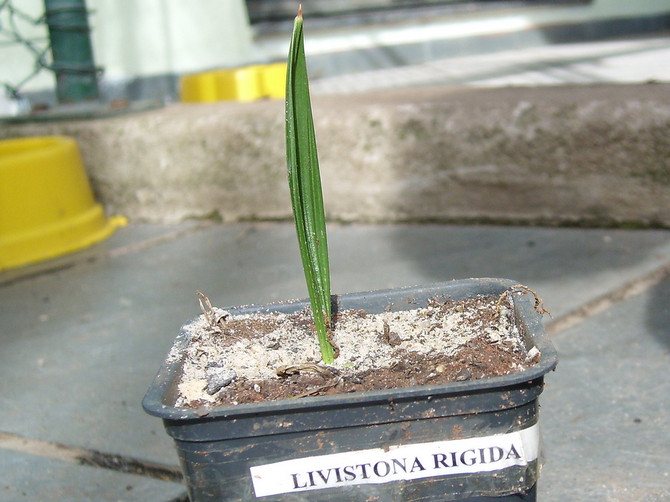

Liviston palm is propagated by seeds, which are sown in late February - early March. Seedlings are planted in individual containers shortly after germination. Transplanting seedlings early will allow the root of the plants to develop without interlacing and injuring each other. It takes several years for such a sprout to turn into a beautiful palm tree.
How to grow a palm tree Liviston: breeding methods
Like many domestic palms, Livistona is primarily propagated by seed. The success of growing from seed depends on the quality of the planting material.If the seeds are fresh, then the seedlings hatch after 4 months, otherwise they can be expected for six months or not at all.
Before sowing, it is advisable to soak the seeds for 3-5 days in warm water at room temperature. If you dip the planting material in a 2% solution of potassium permanganate for 10-15 minutes, you can accelerate the emergence of seedlings by 5 days.
For a very long time, flower growers have been using the sowing method proposed by the Russian botanist S.G. Ginkul. A cloth soaked in water is placed at the bottom of the sowing container, the seeds are laid out tightly to each other on it, and the top is covered with the same wet piece of cloth. The container is covered with glass and in the future they make sure that the planting material and cloth do not dry out.
This method is good in that you can easily see the germinated seeds and plant them one at a time in 5-6 cm pots with soil mixture for seedlings:
- 2 pieces of light turf land;
- 1 part of leaf, humus or greenhouse and sand.
A more common way is to simply sow seeds into a wet soil mixture of the specified composition to a depth of 1 cm, cover the container with polyethylene or glass and put it in a warm place. Water and air the mini-greenhouse regularly, and when shoots appear, gradually accustom them to room conditions. Seedlings are transplanted into independent pots with 2-3 leaves.
Very rarely, a sufficiently mature palm tree forms lateral offshoots, which Livistons use for reproduction. They are carefully separated during transplanting, trying not to damage the roots, and are planted in a separate flower container filled with a substrate for young palms.
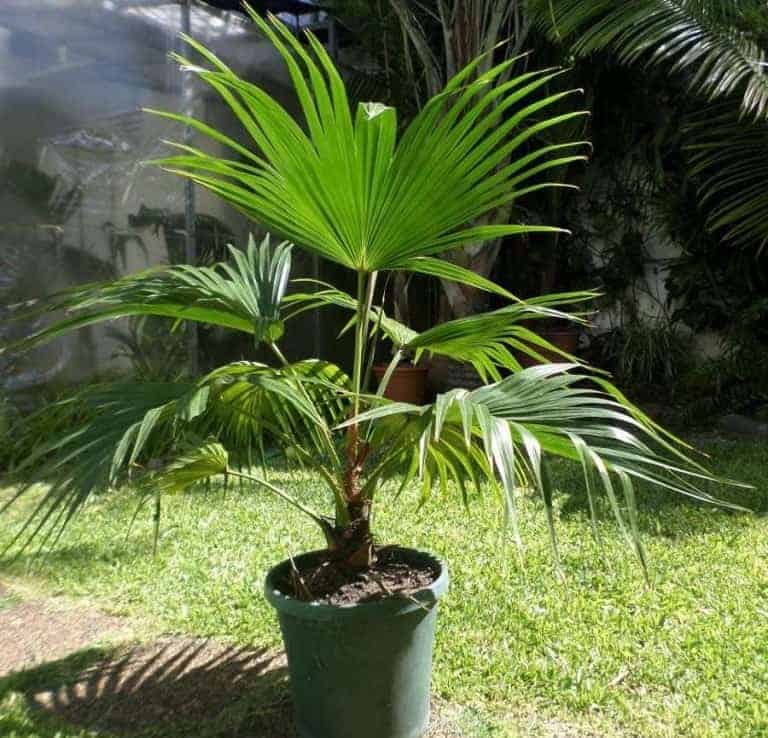

Pruning
Drying the leaves from their tips spoils the appearance of the plant and makes you want to remove damaged branches as soon as possible. However, this cannot be done until the leaf is completely dry, including the petiole. If this rule is not followed, they will begin to turn yellow and dry faster and faster, and the growth of new fronds may stop. The reason for this lies in the location of the growth points of palm crops.
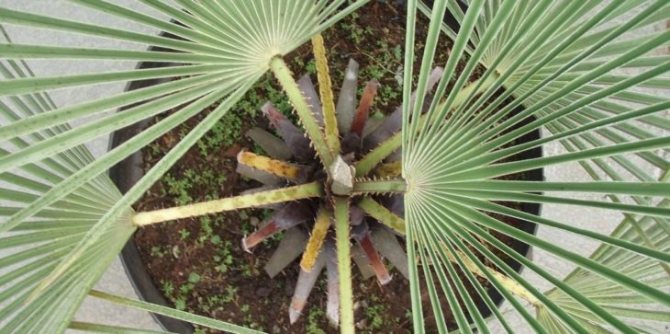

Buying ready-made palm seedlings
When buying grown seedlings of this culture, preference should be given to plants with a closed root system and fresh foliage of bright green color without yellow dried tips on the leaves. You should not choose more mature, densely leafy specimens, despite their more attractive appearance. It is better to opt for young seedlings with few leaves. It is necessary to carefully examine the plant for traces of cut leaves - they should not be. It will not be superfluous to look into the drainage hole, healthy white roots should be visible in it. But it may be absent in the shipping container, then you need to try on other signs to understand how long a young palm tree has been in it and what state its root system is in.
It is best to buy a ready-made Liviston palm tree, like any other, in the warm season to avoid traumatic transportation with sudden temperature changes.

